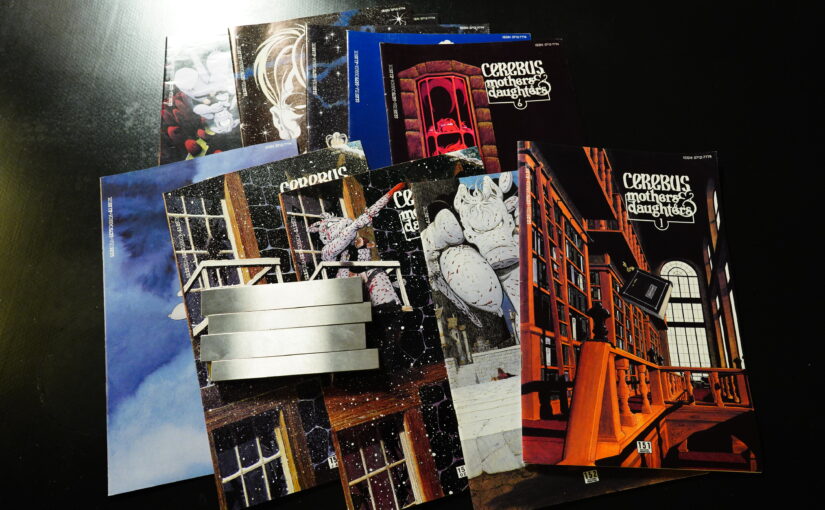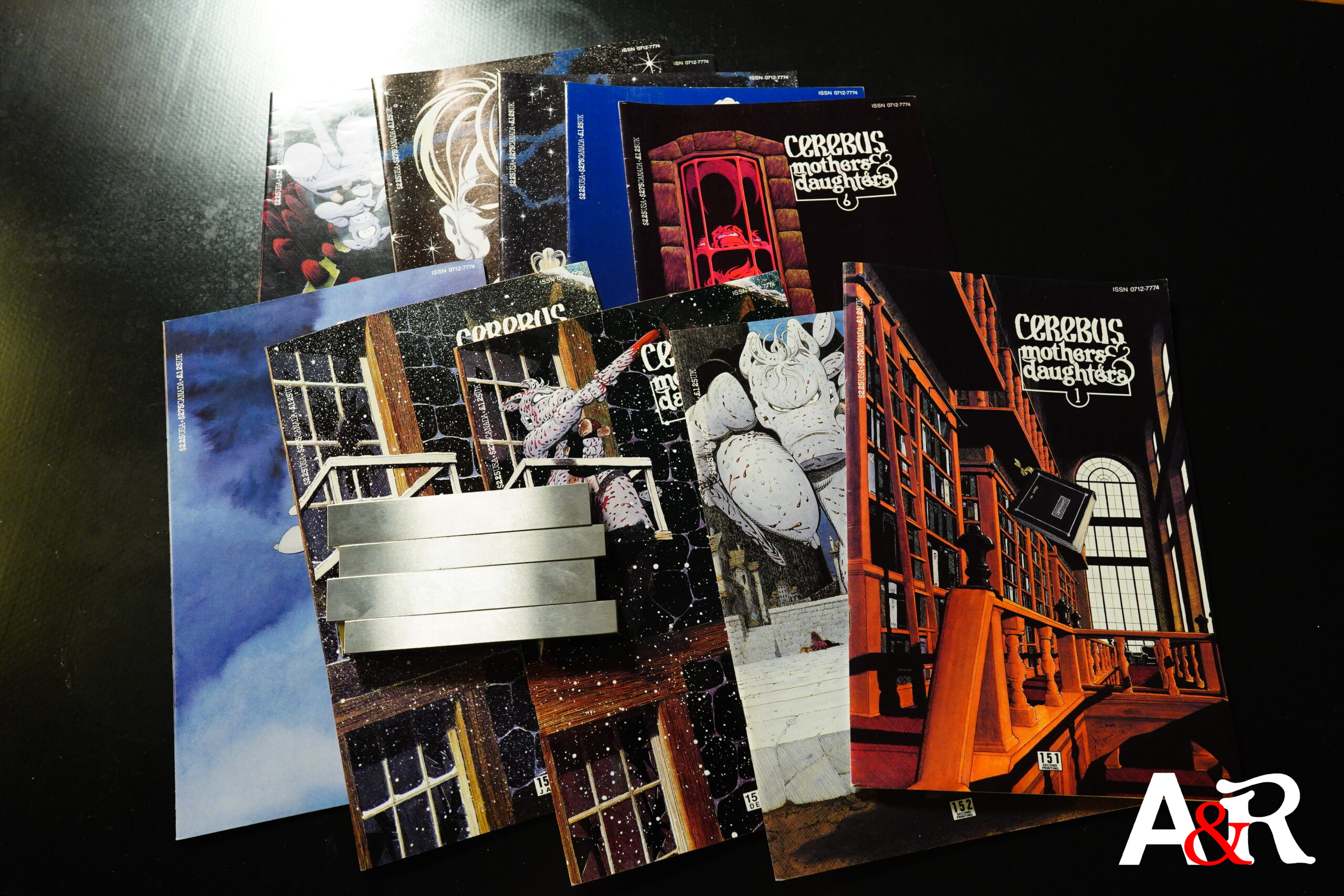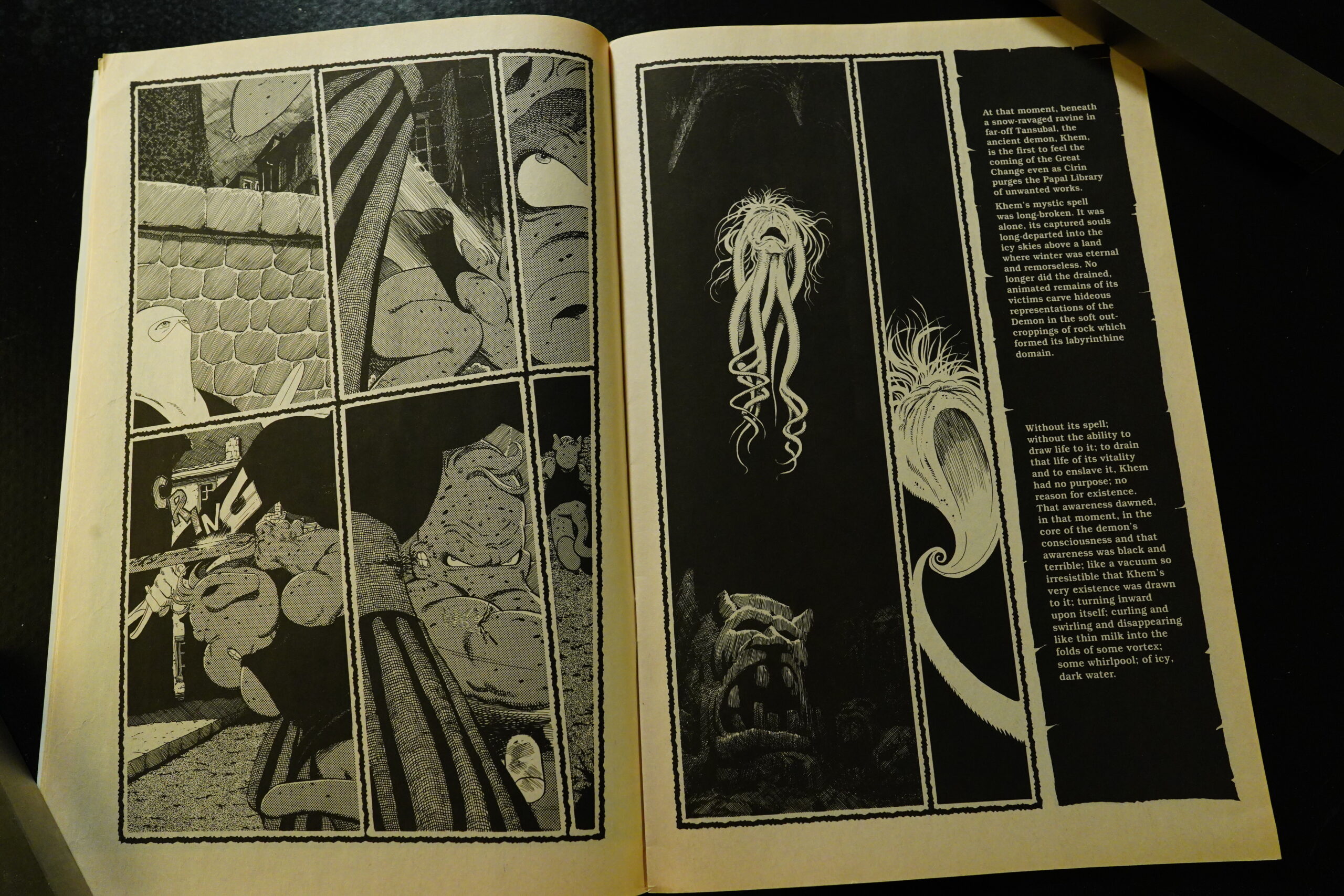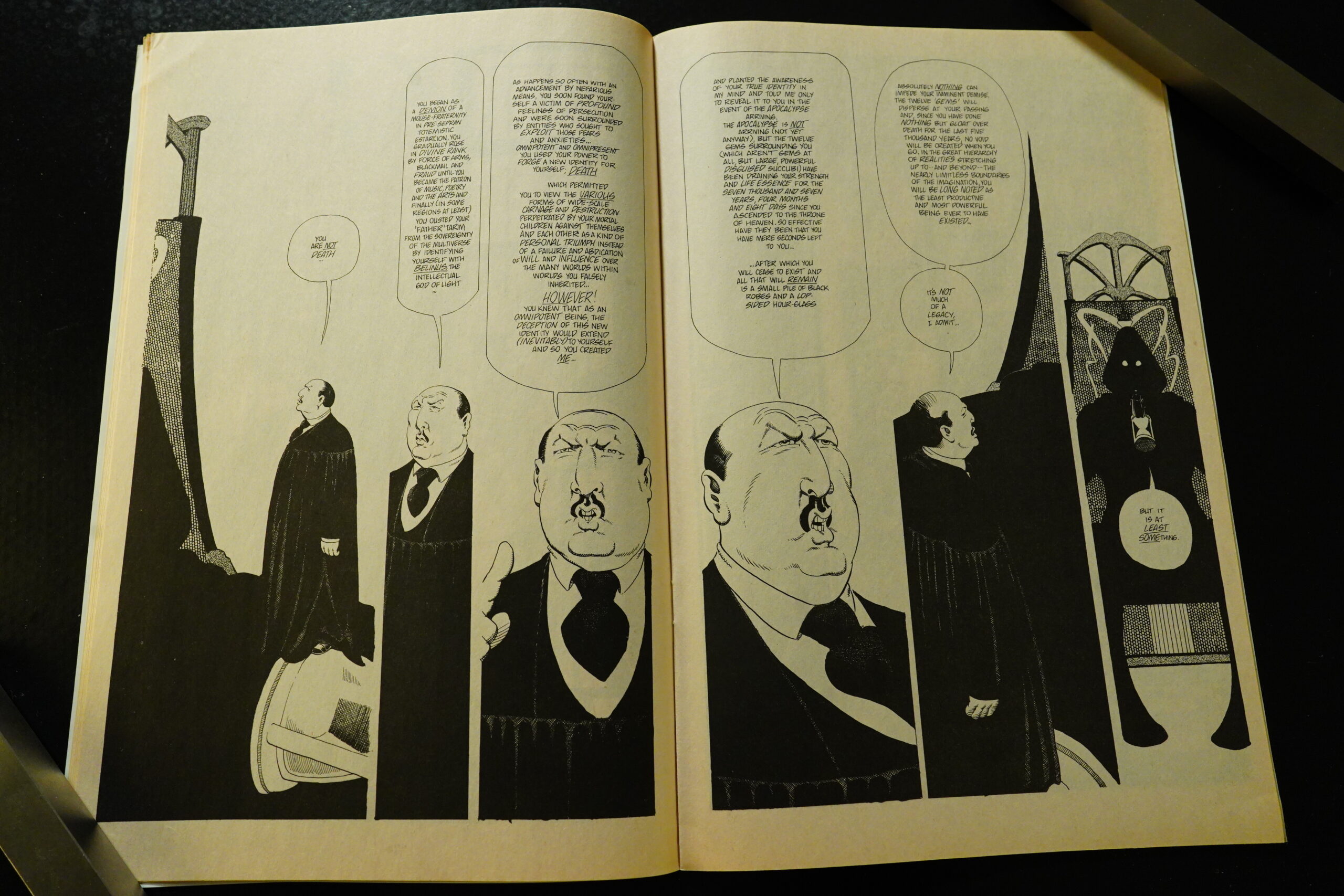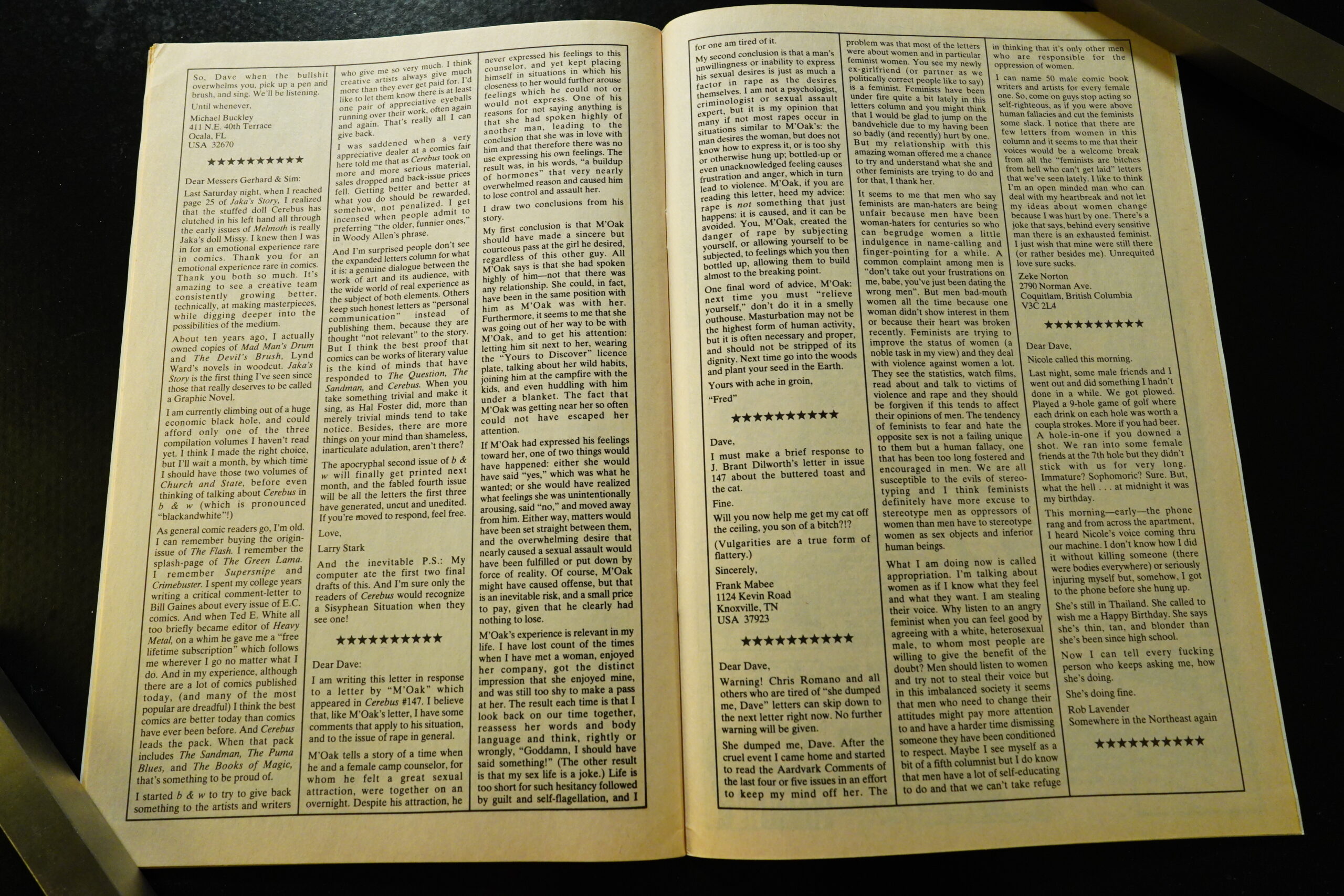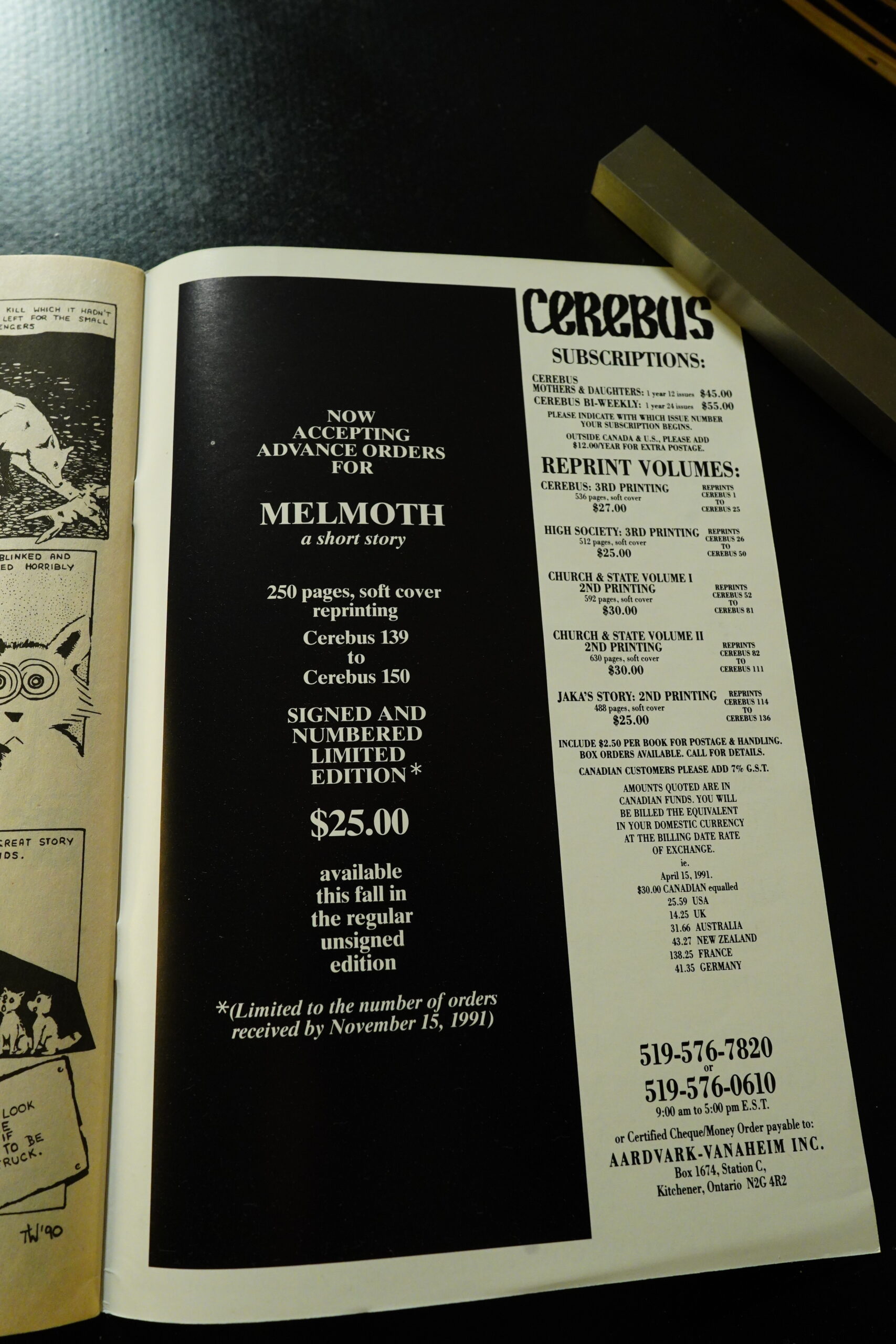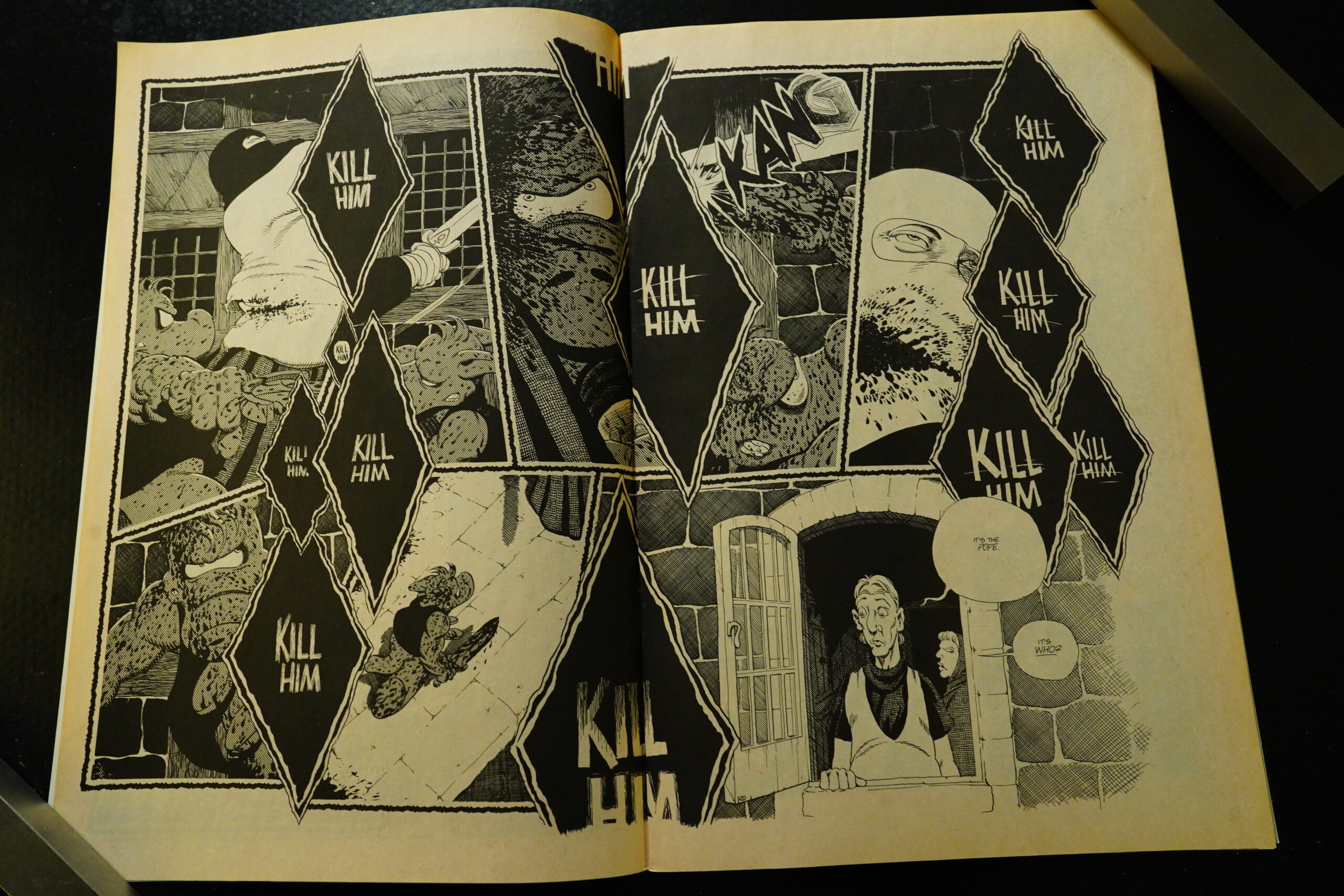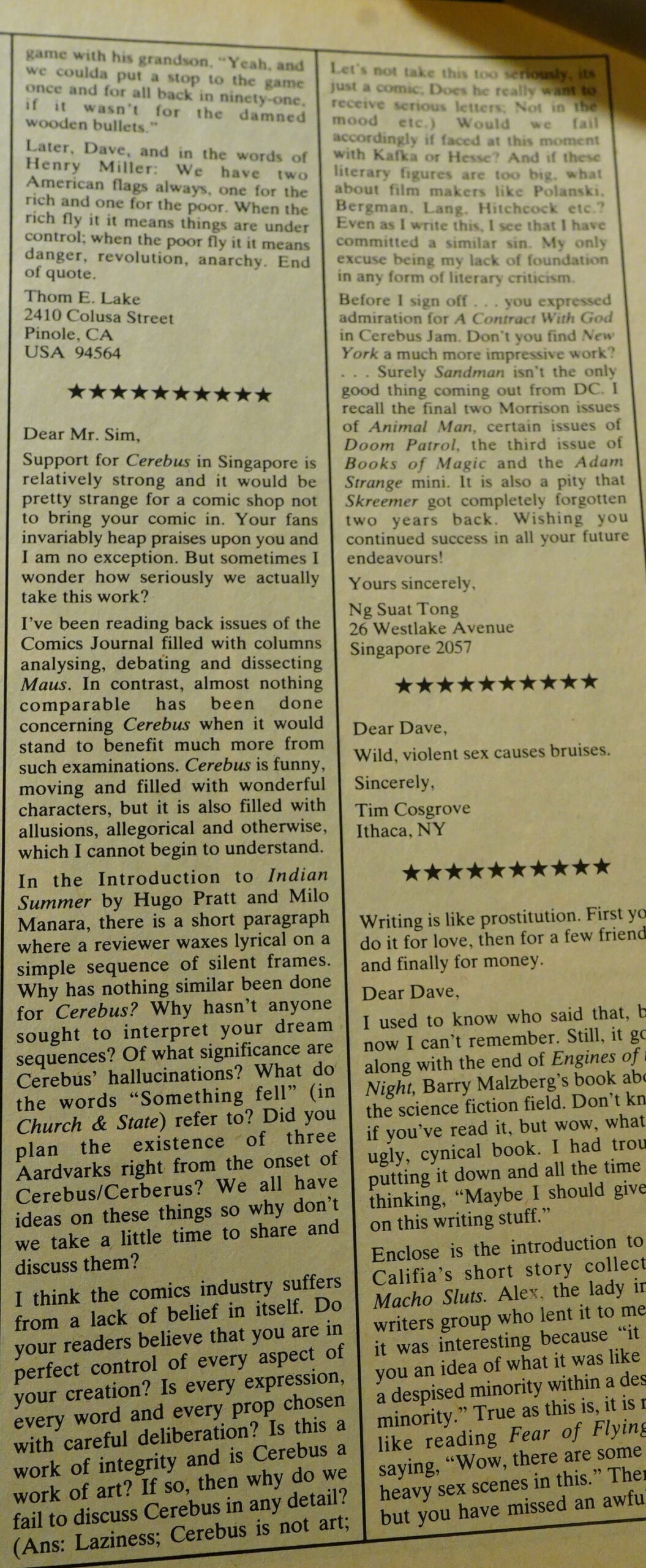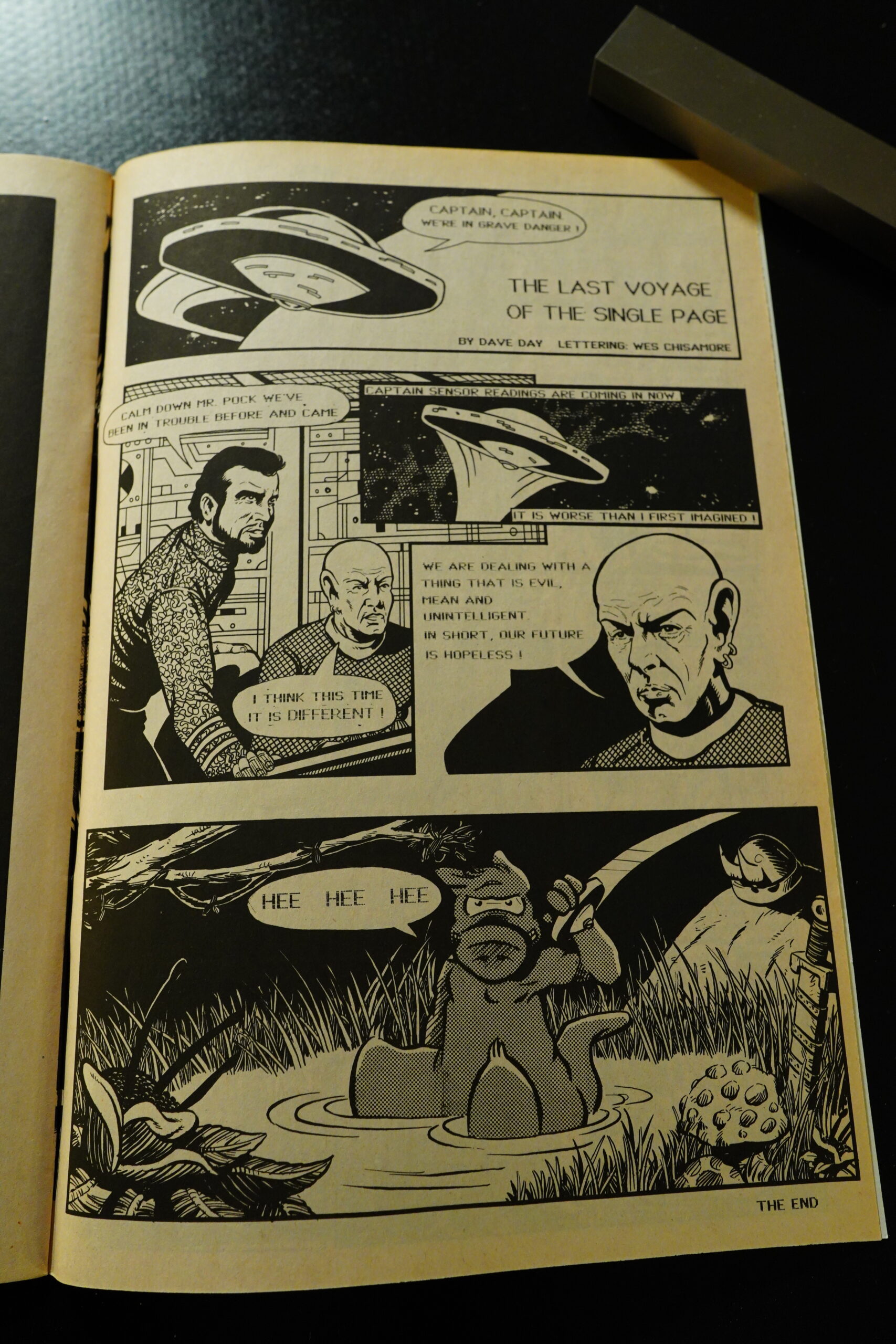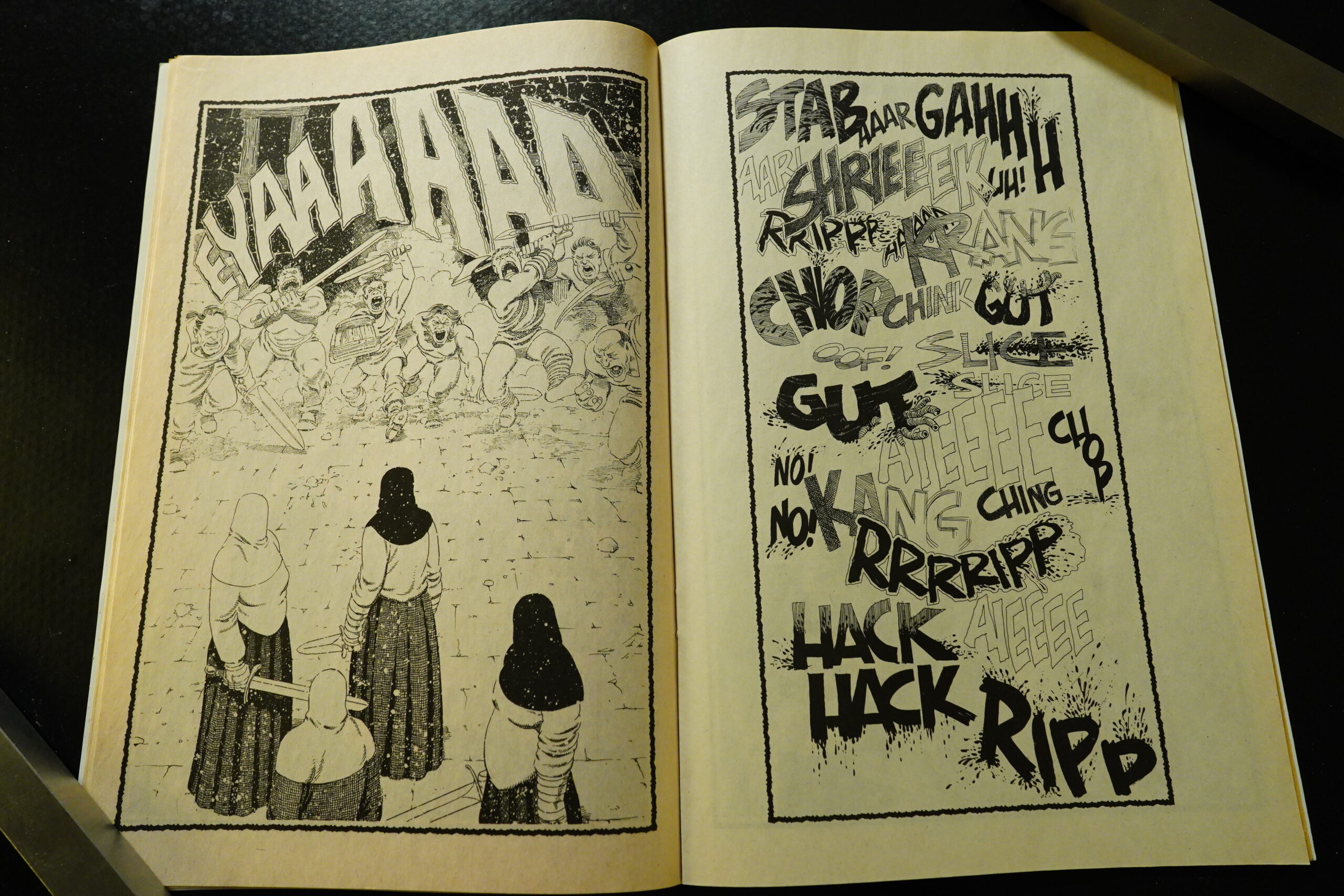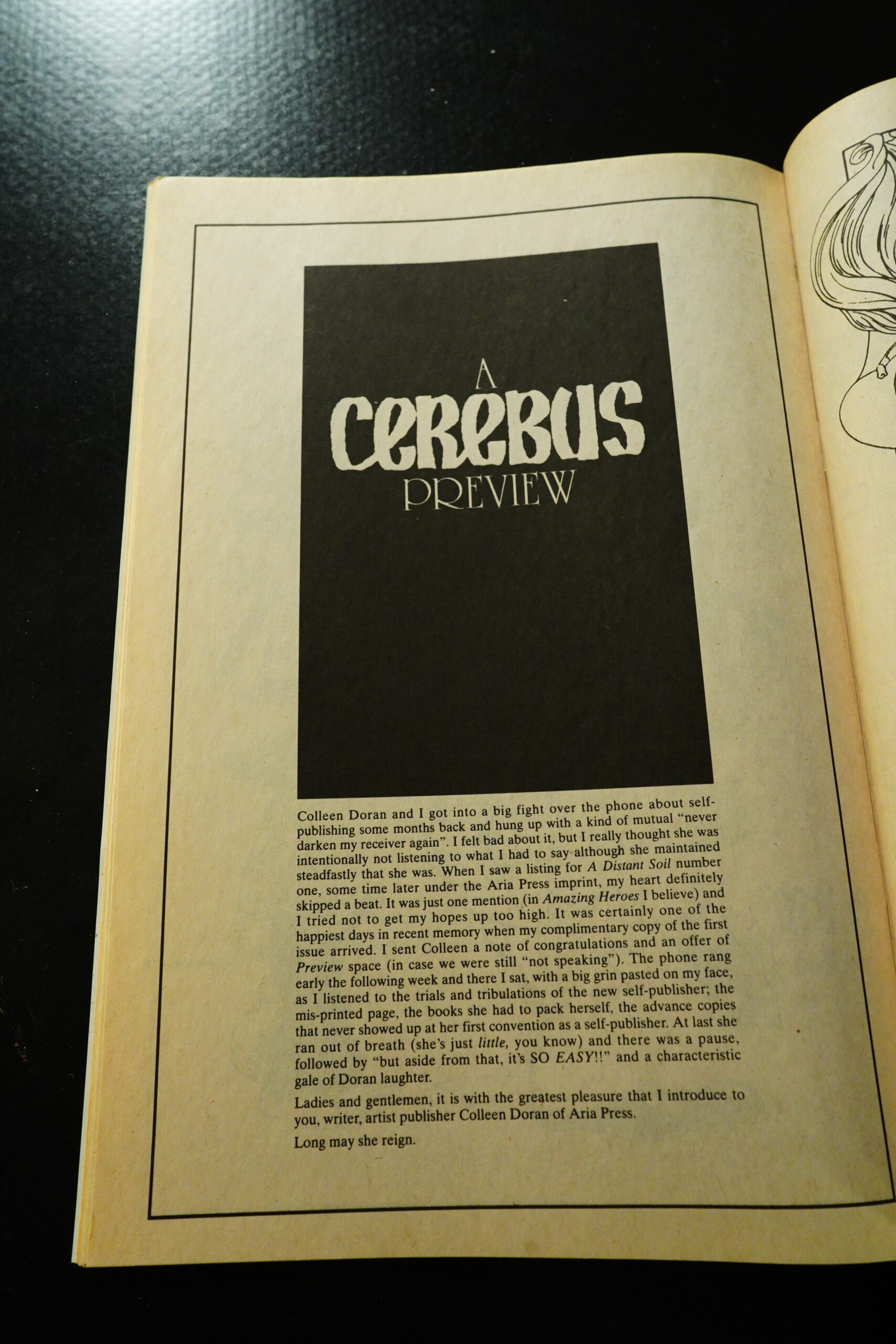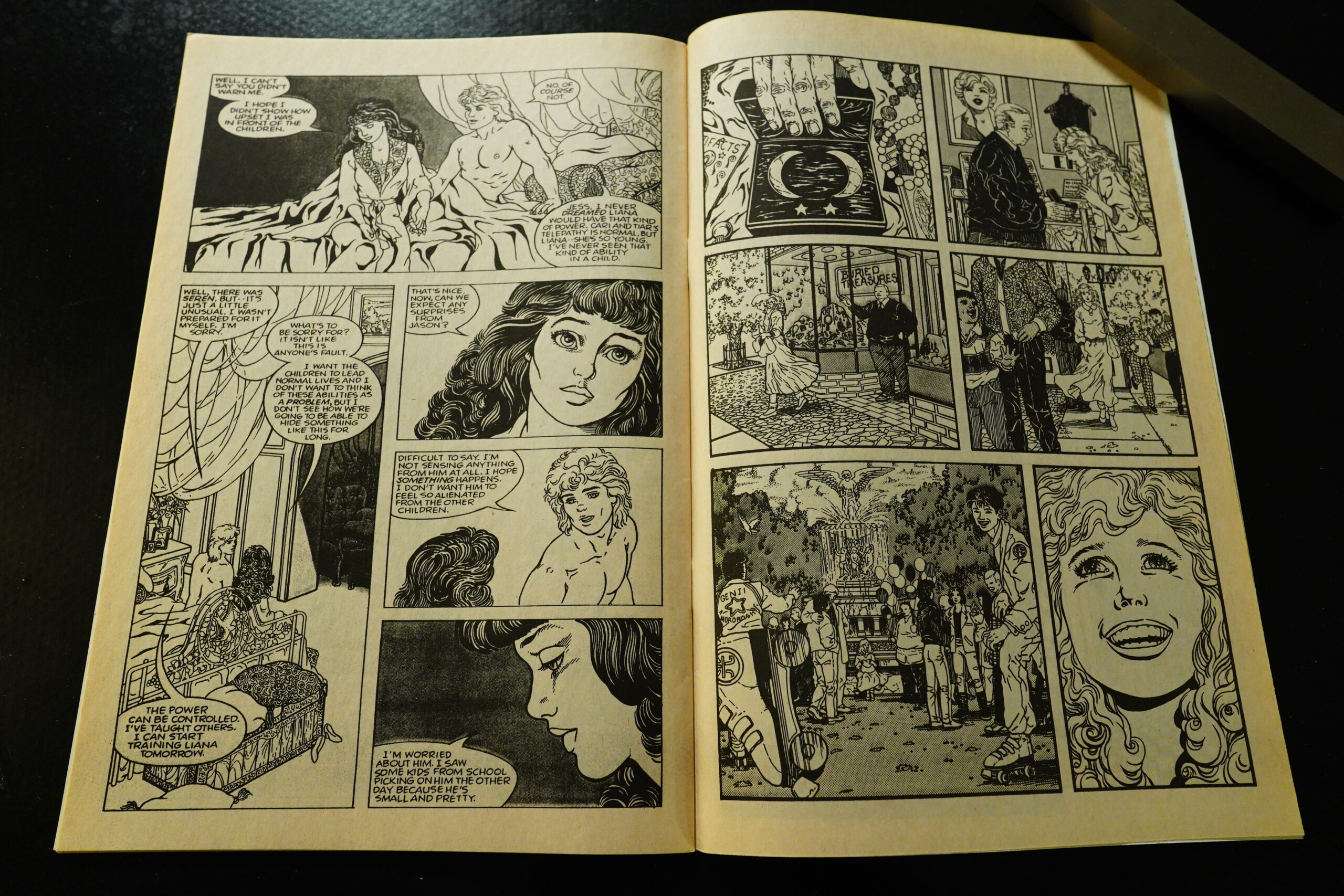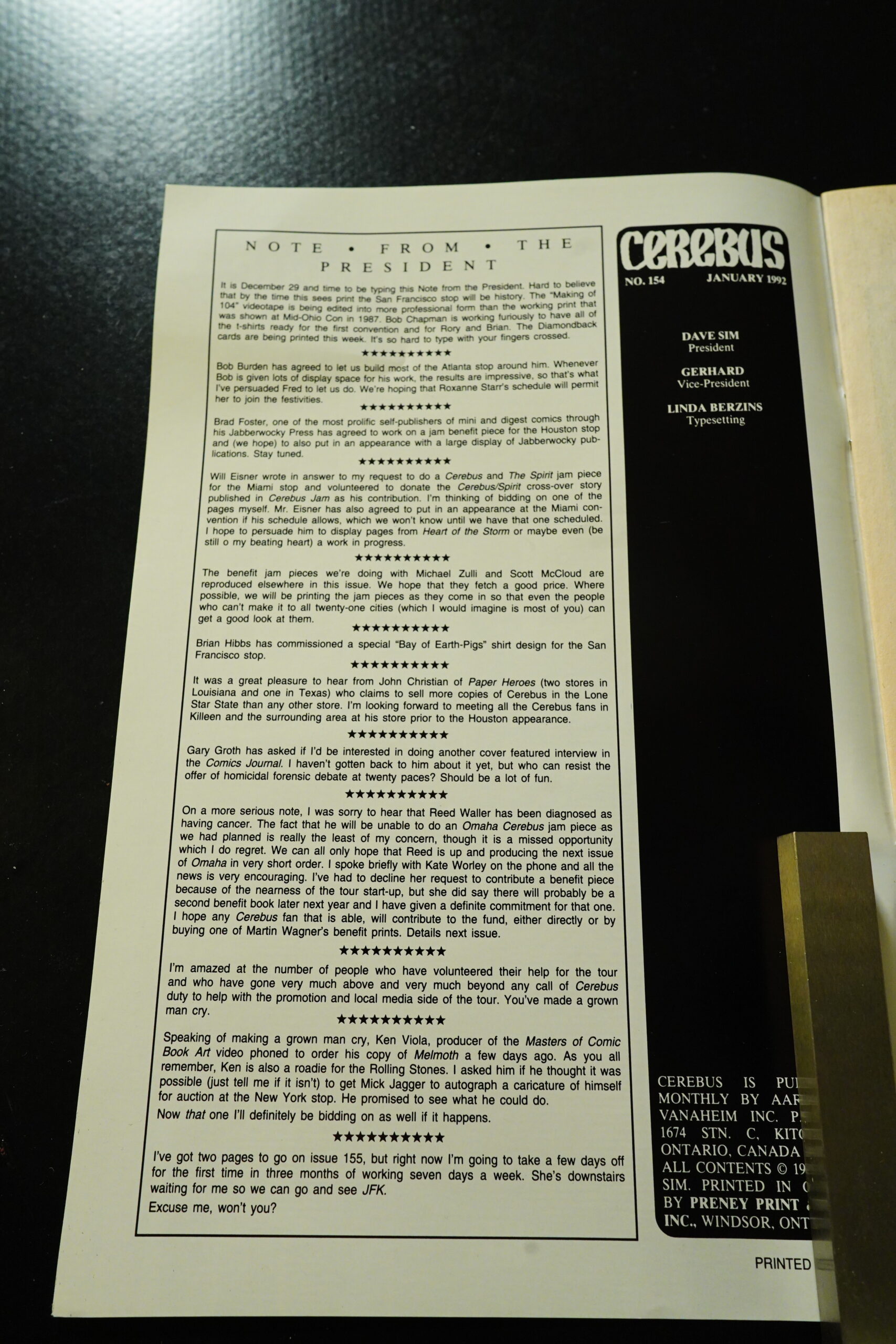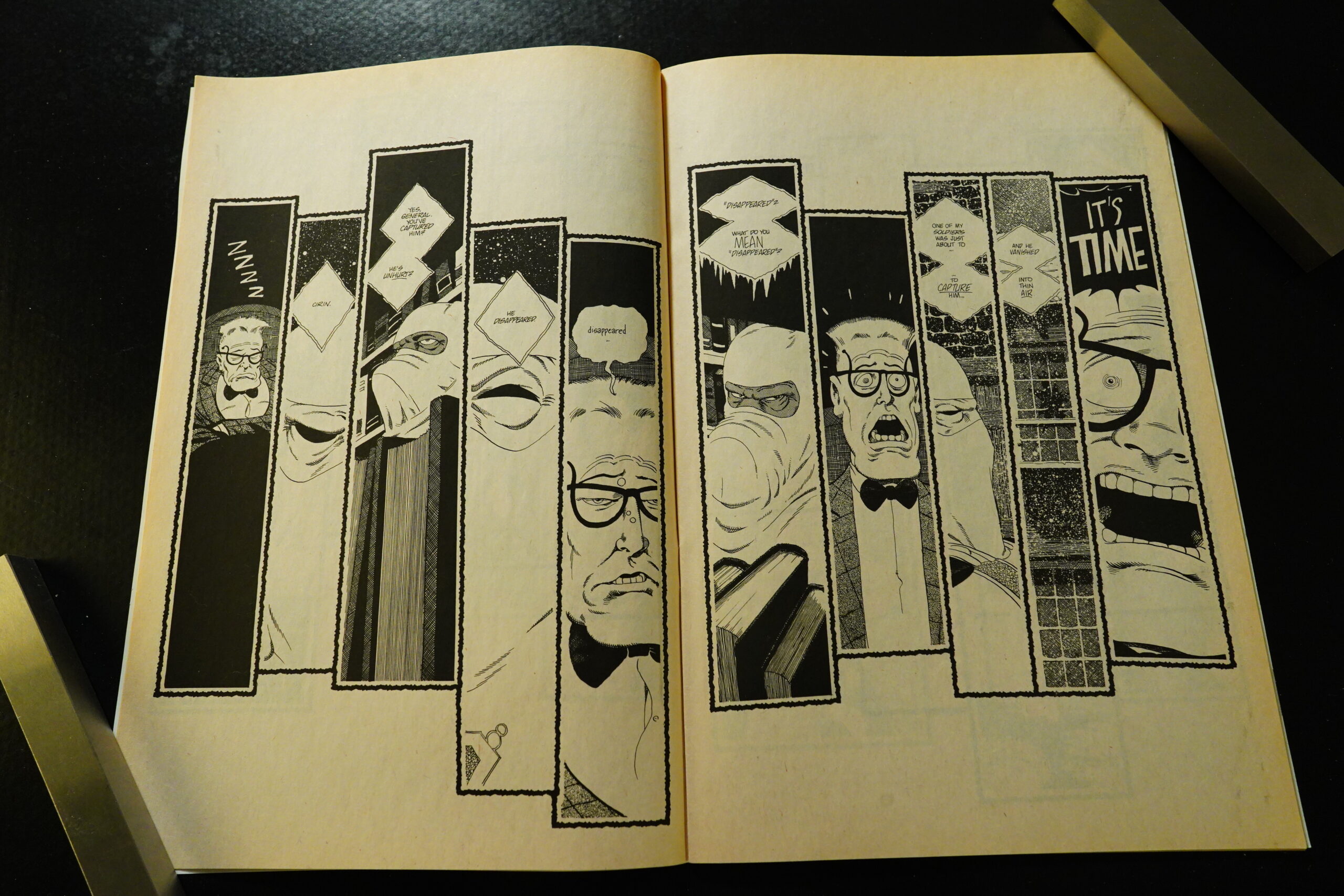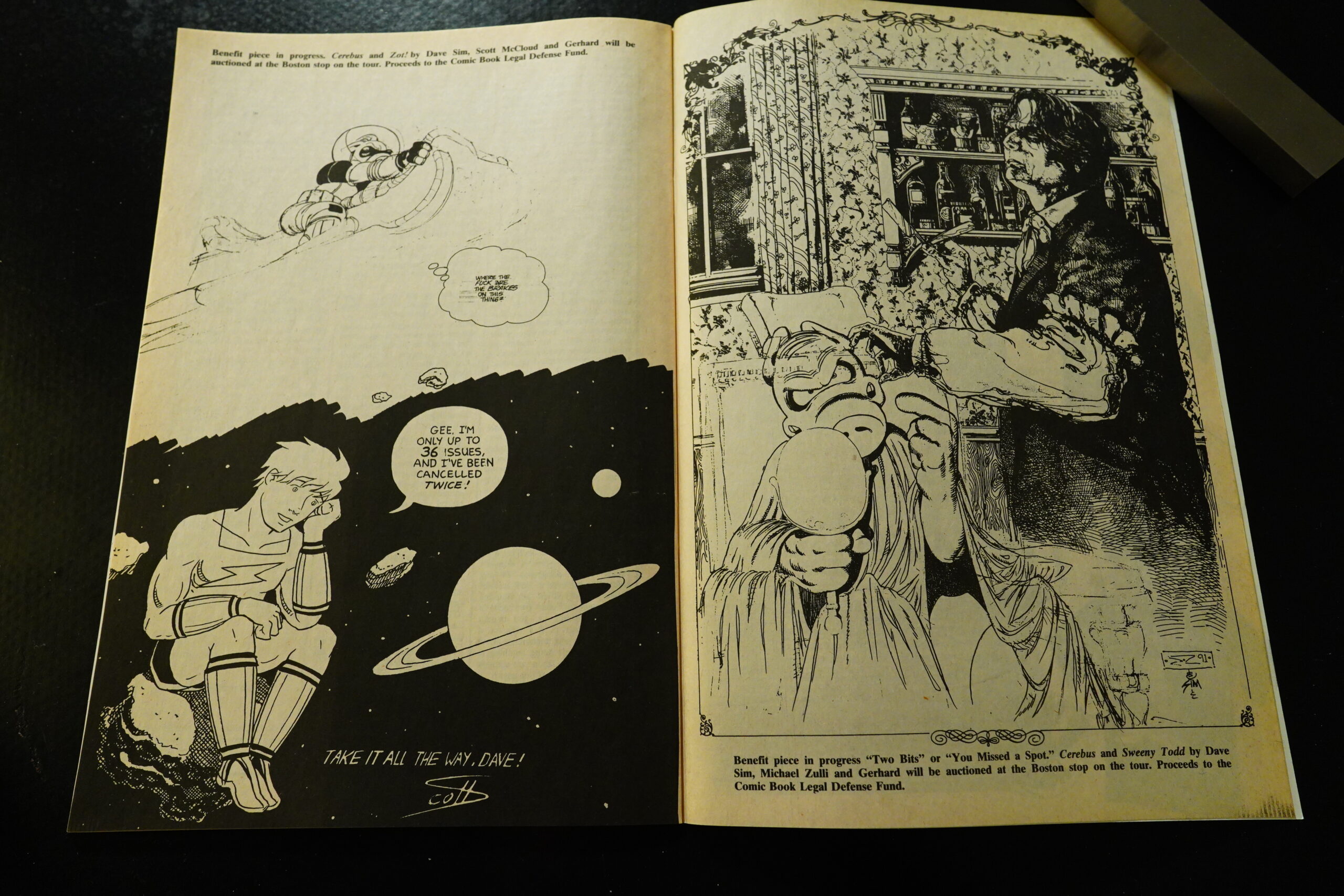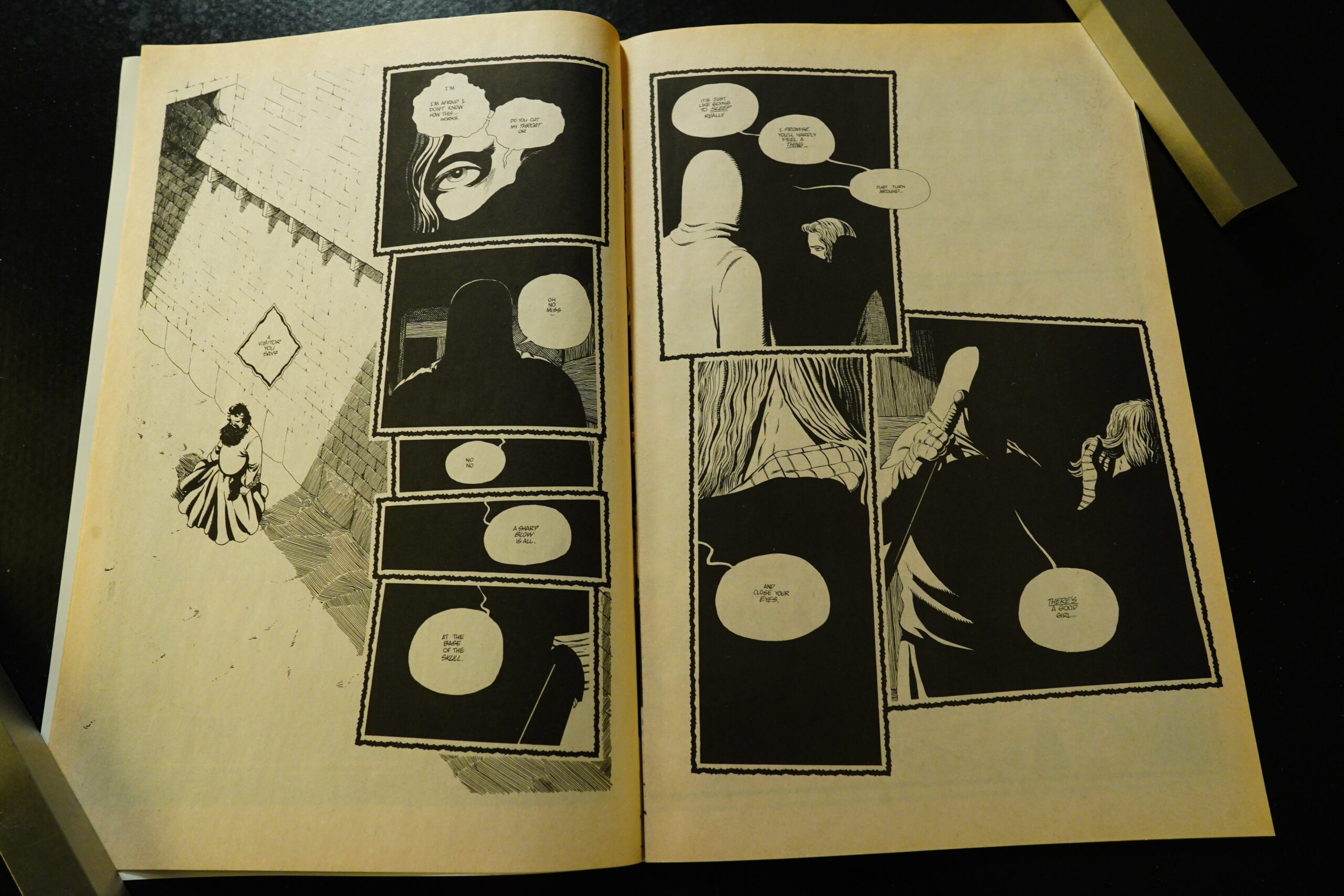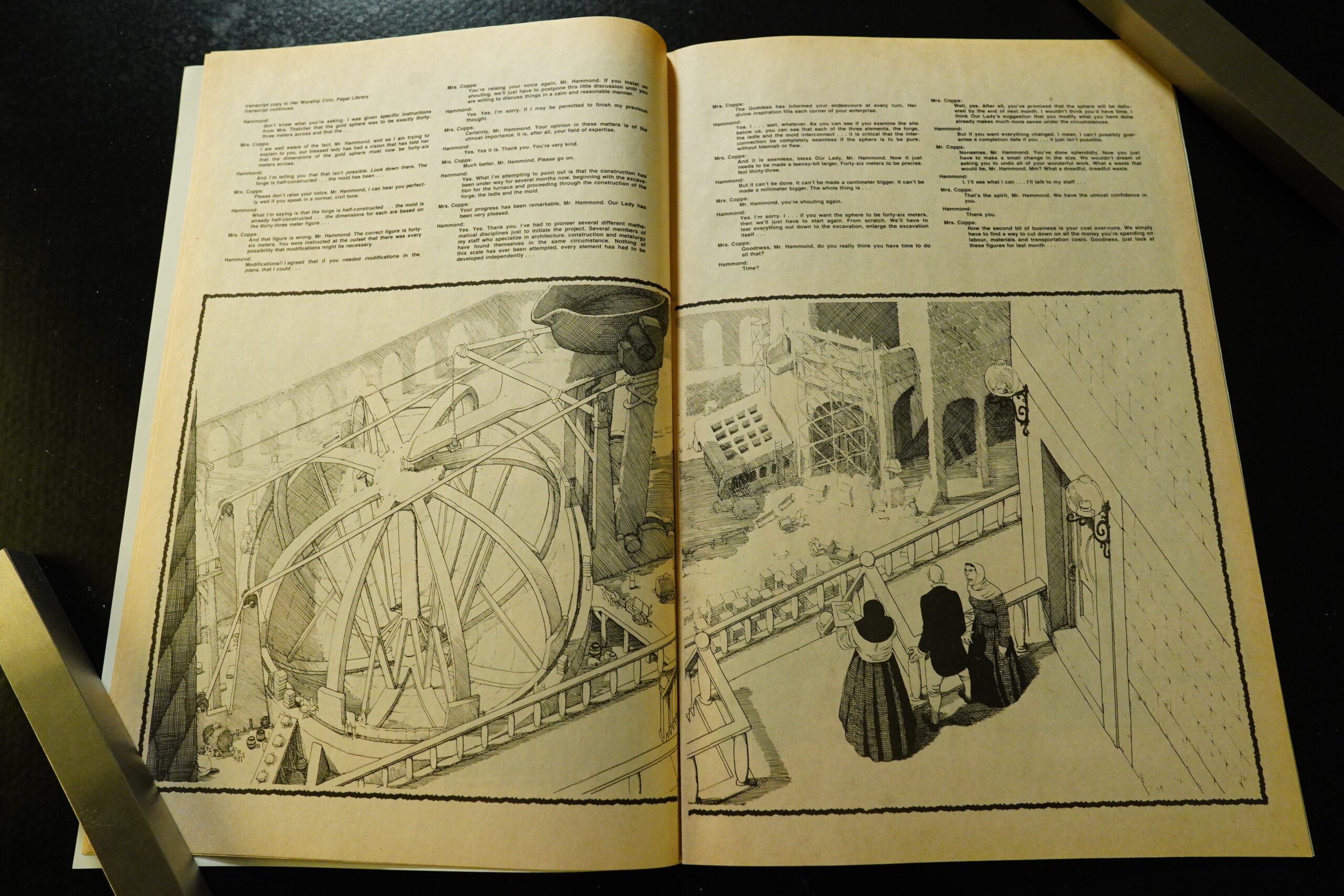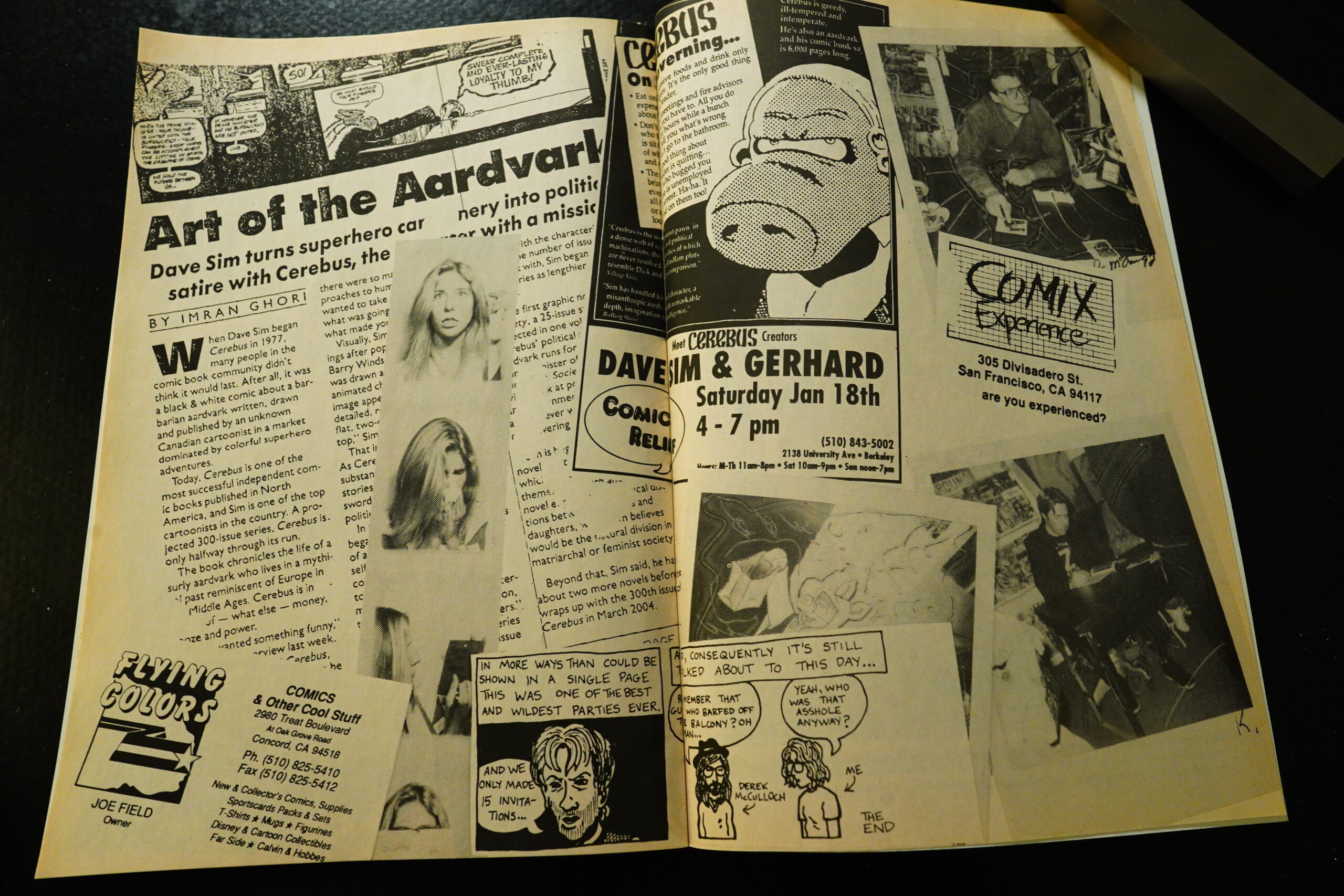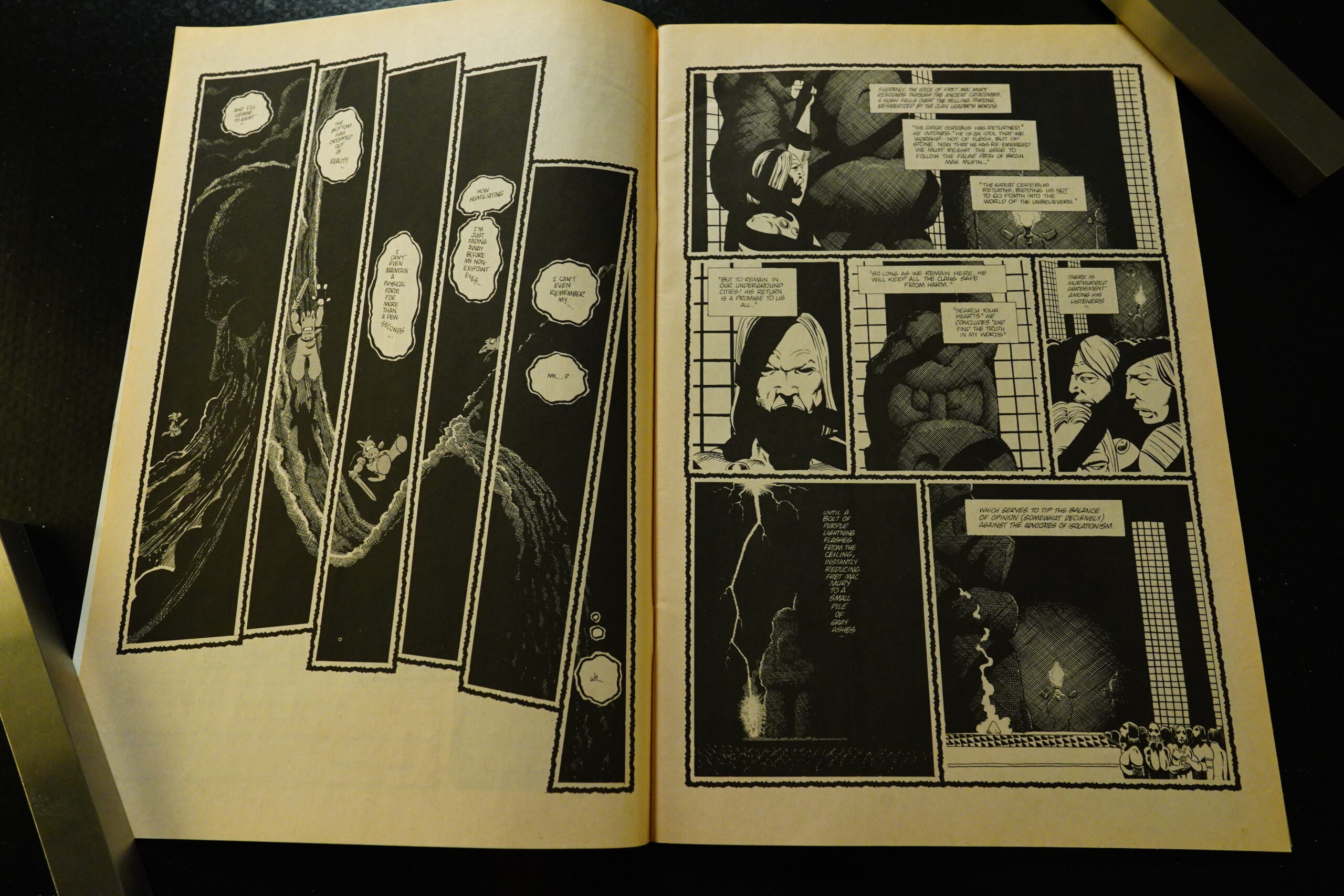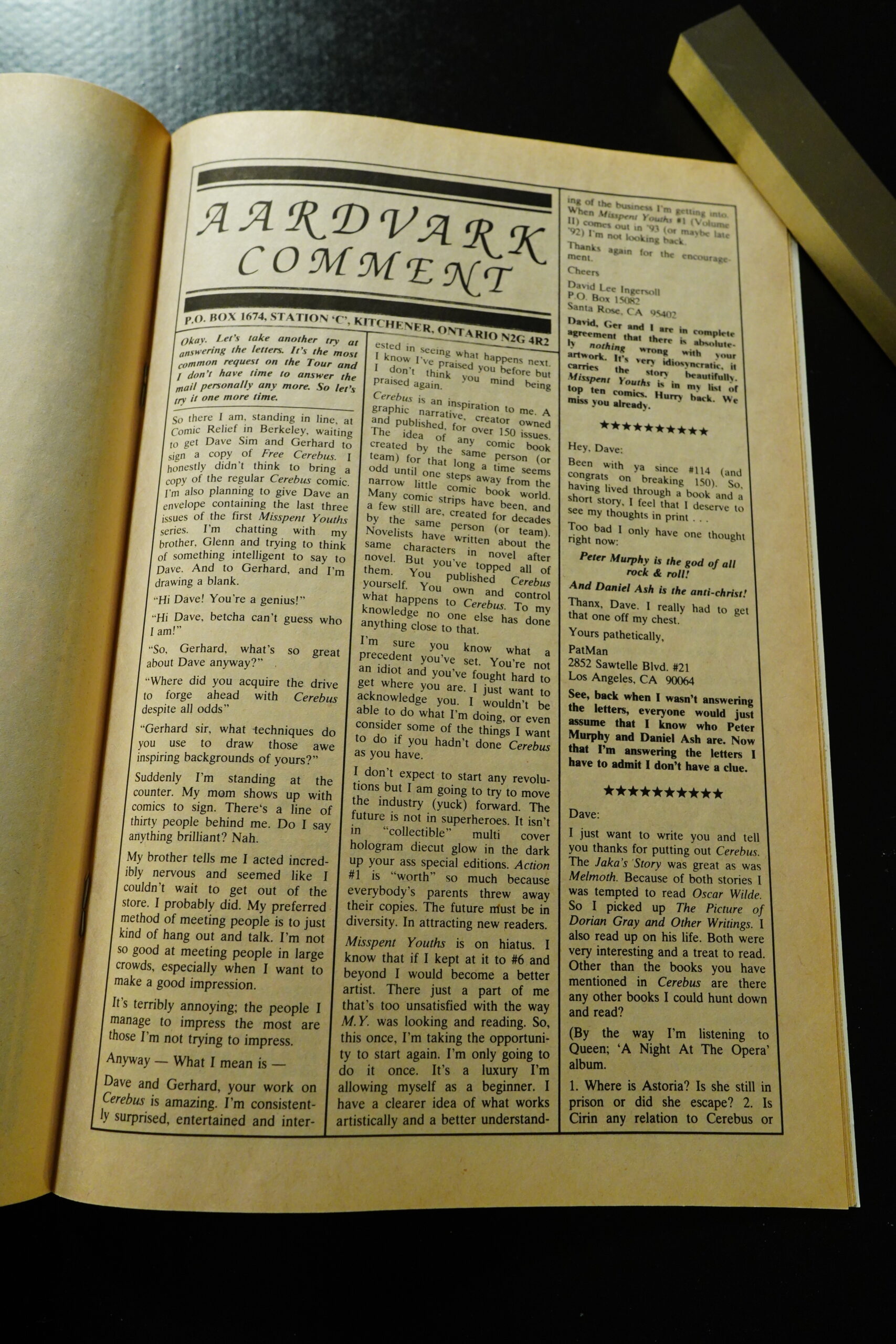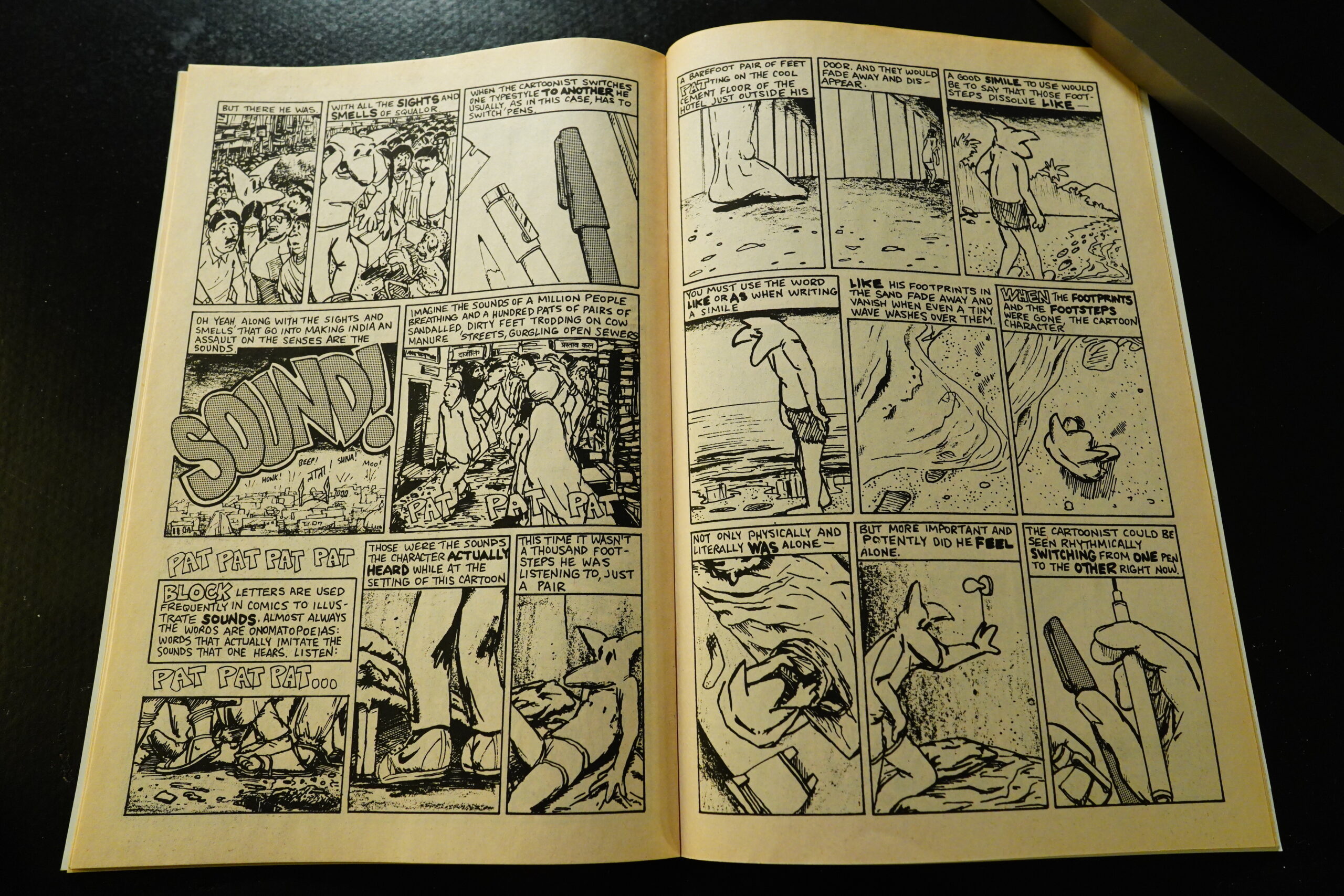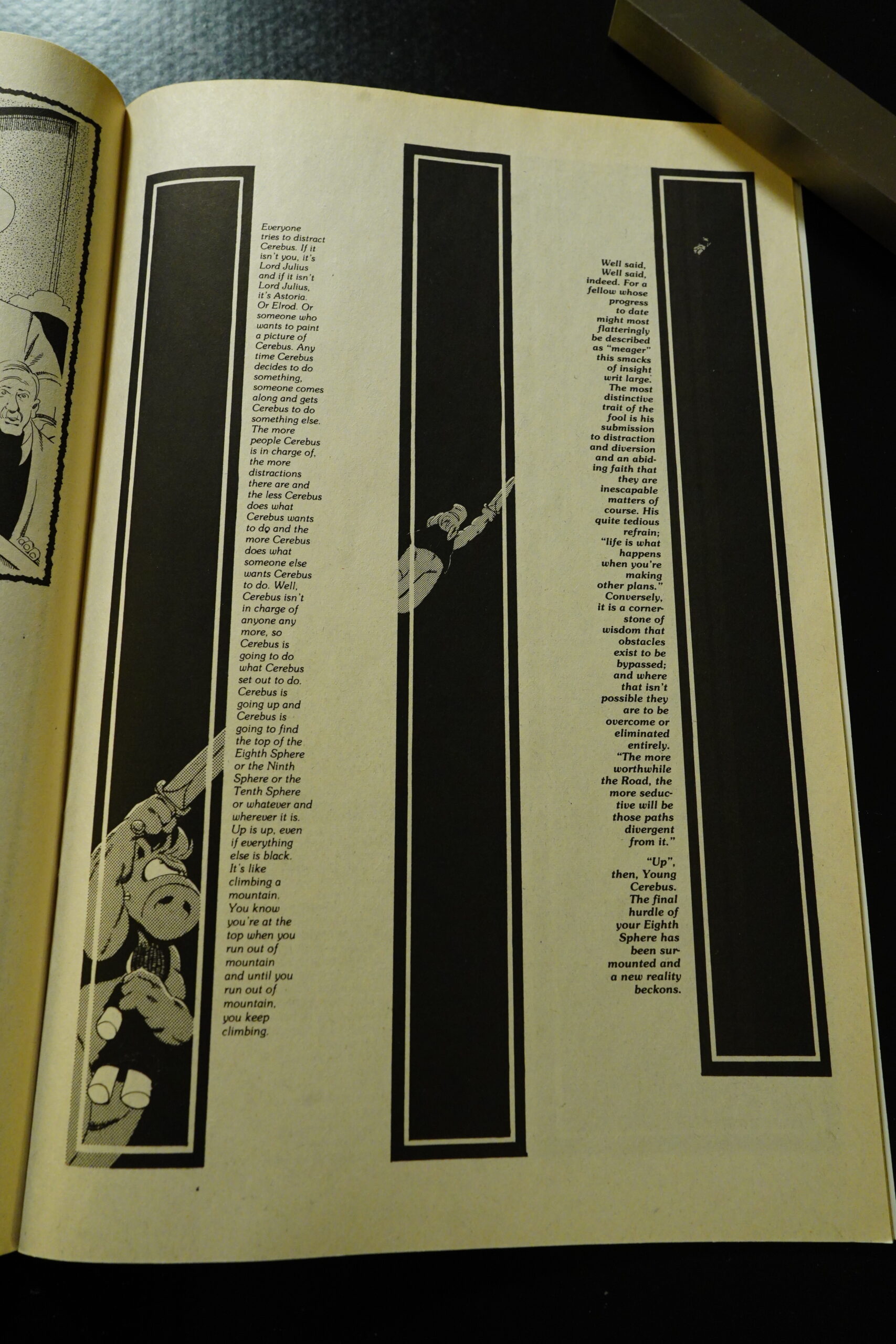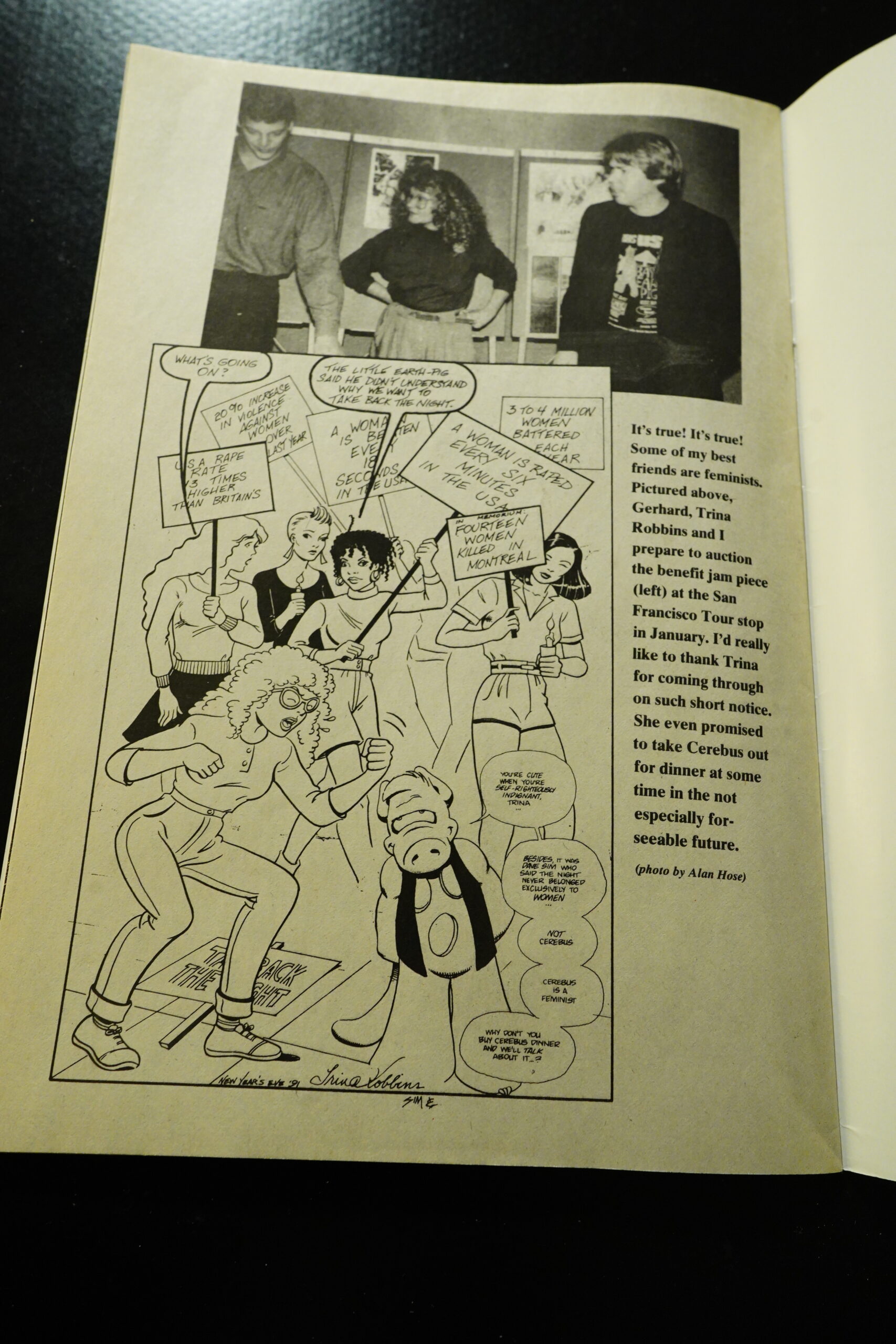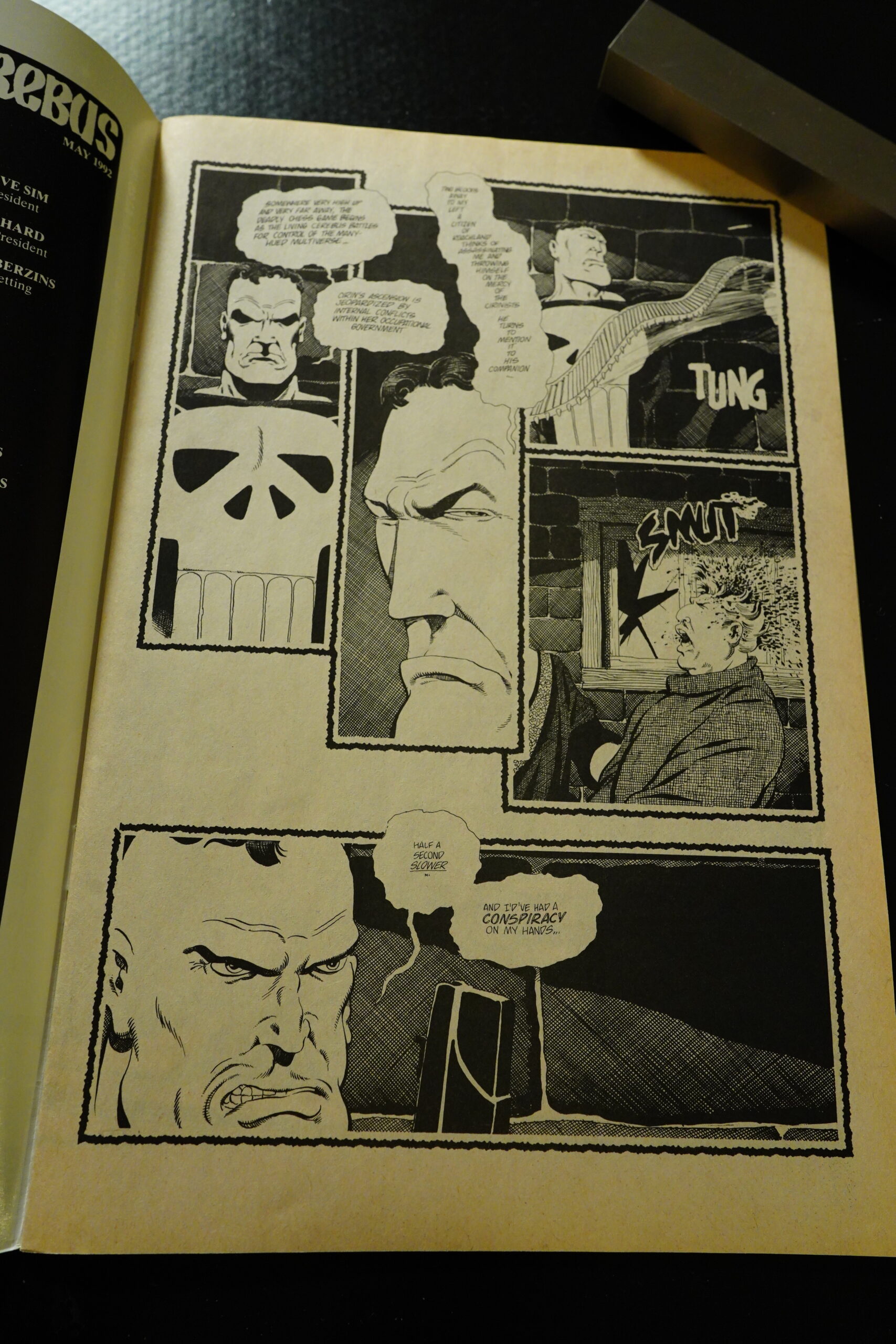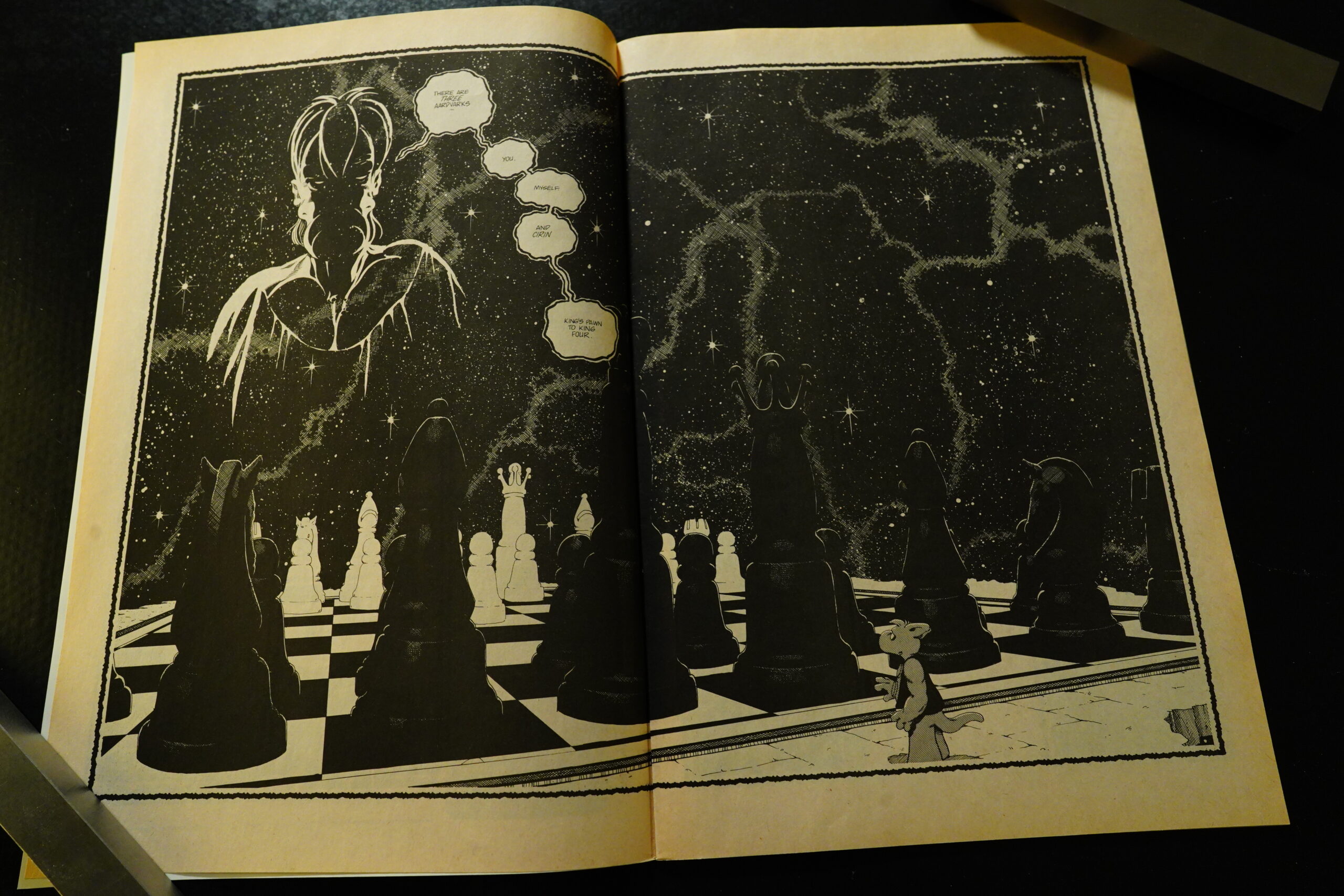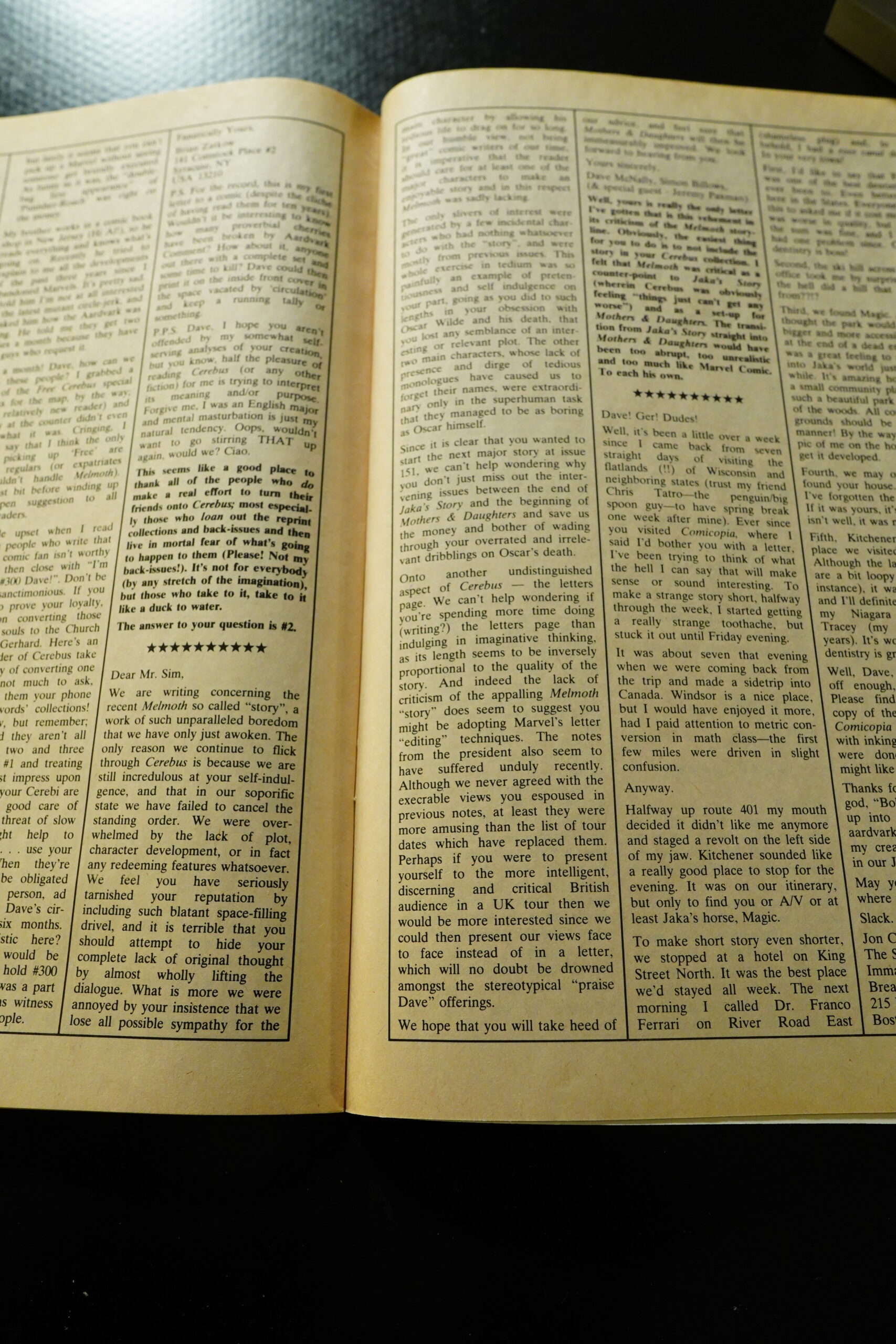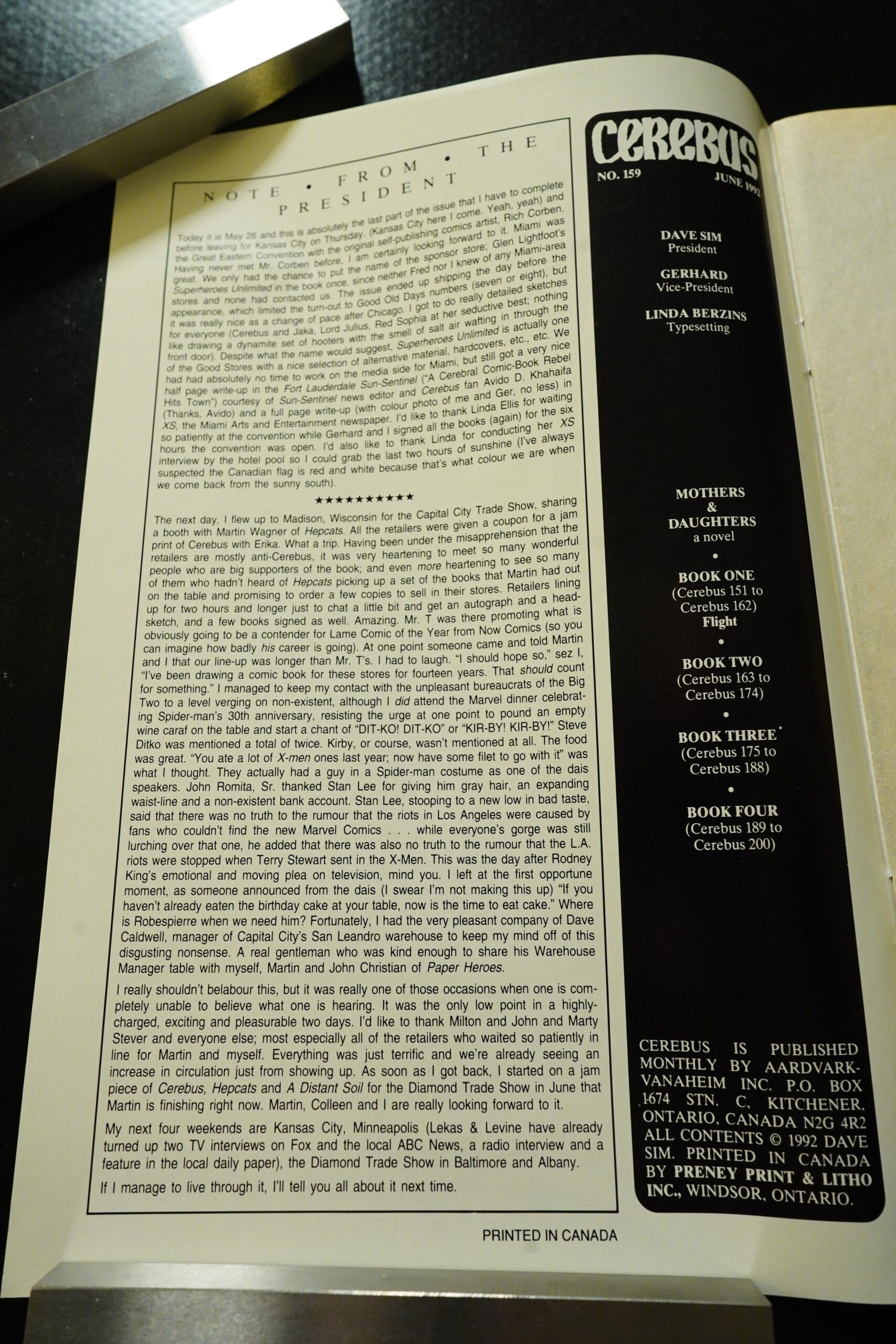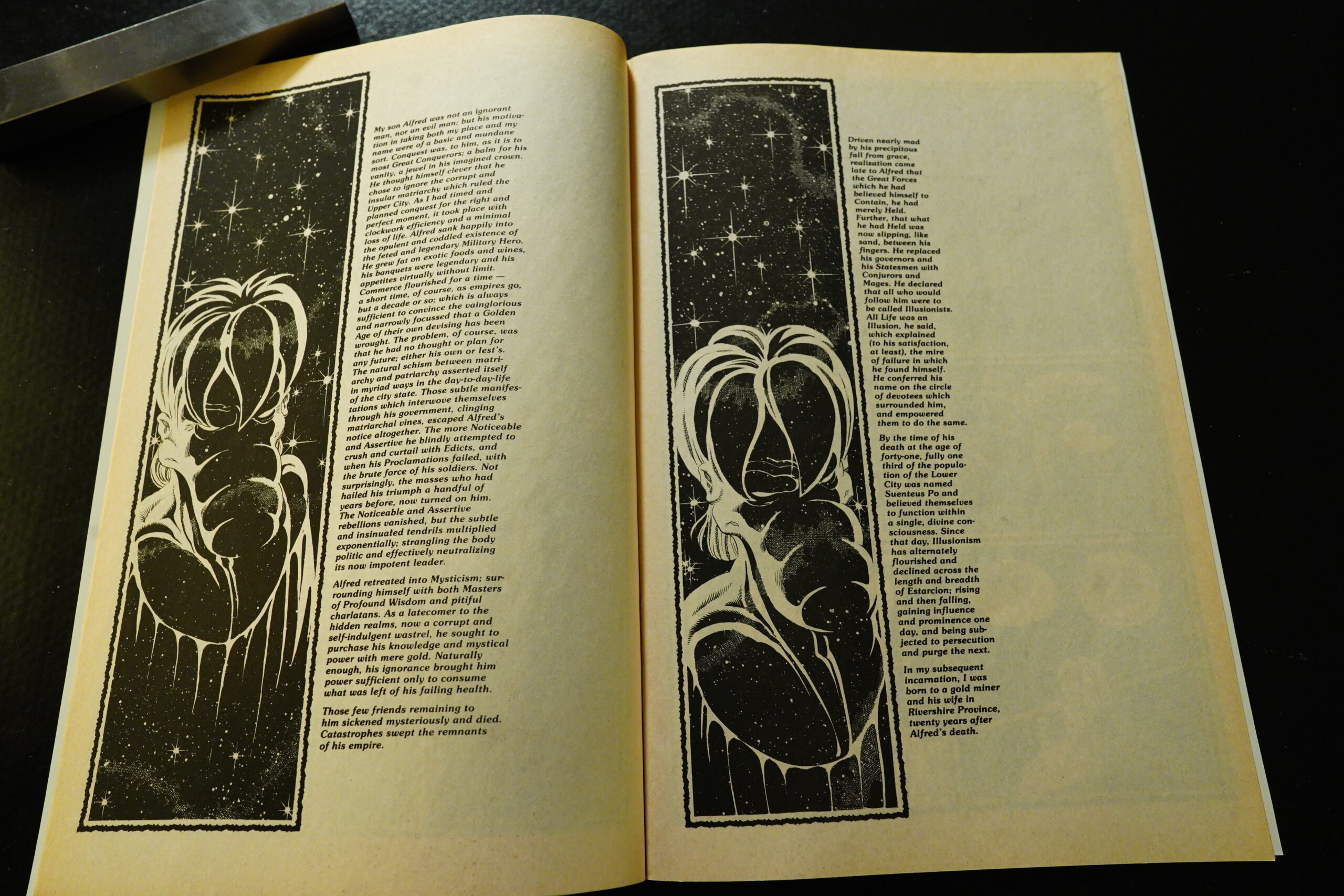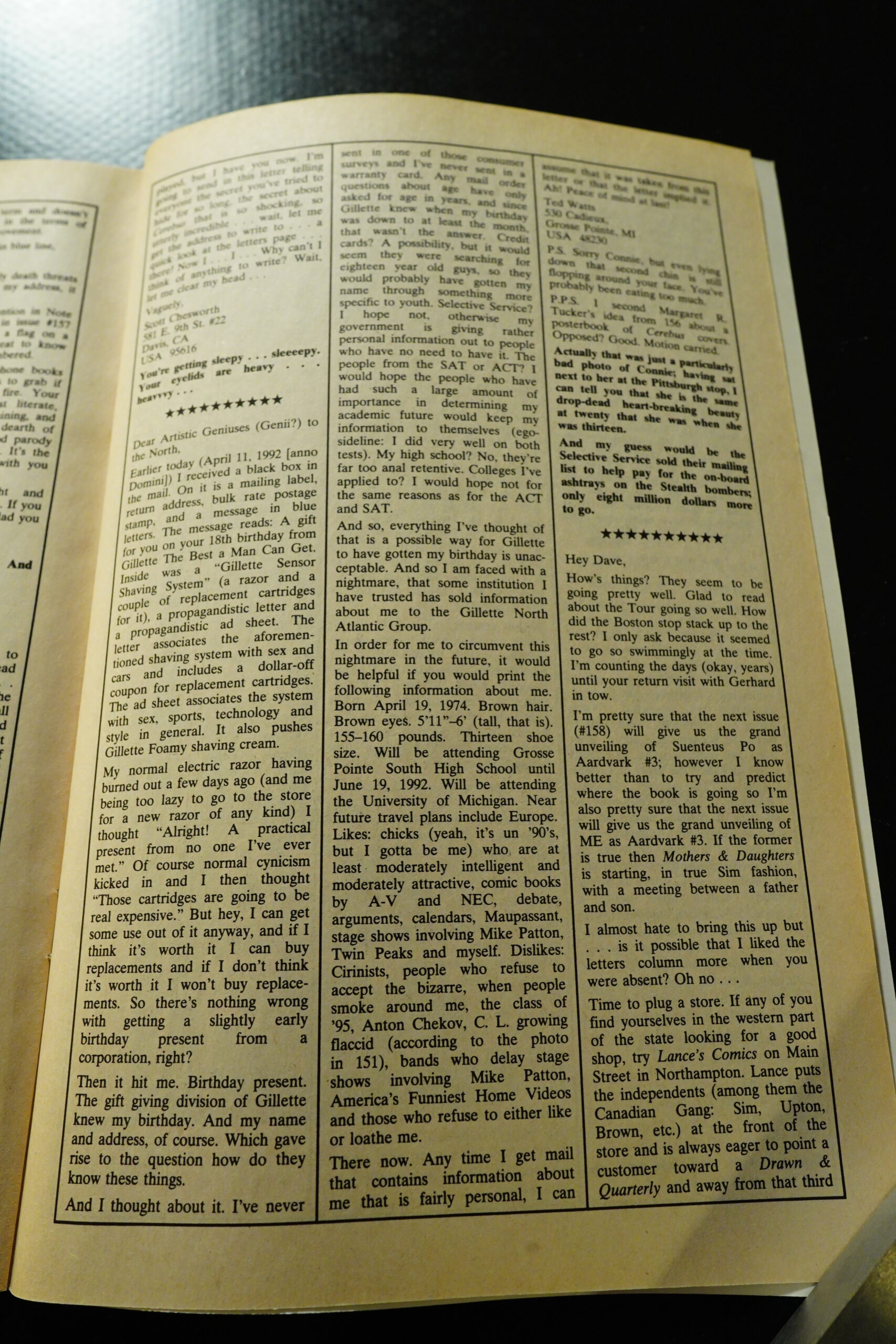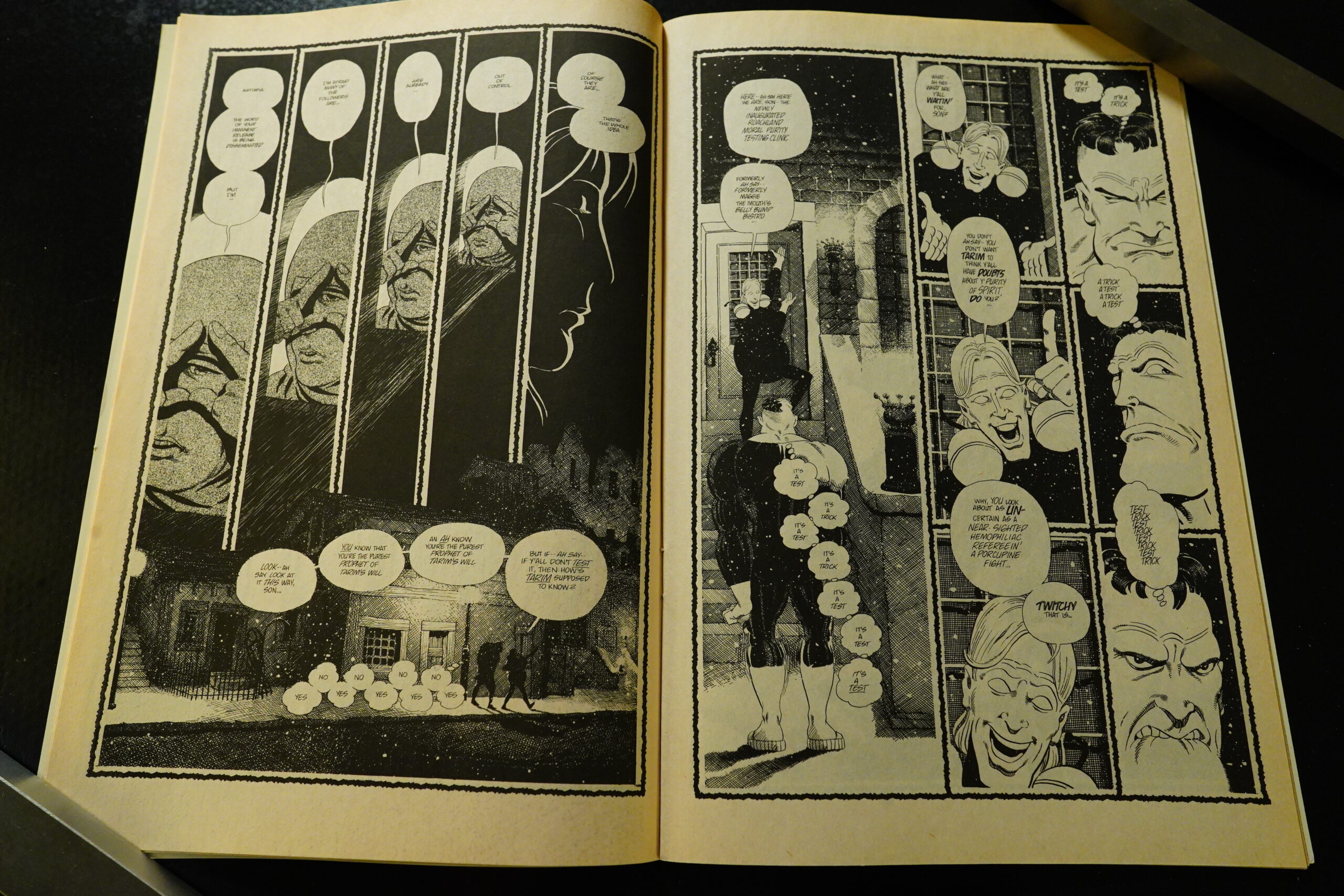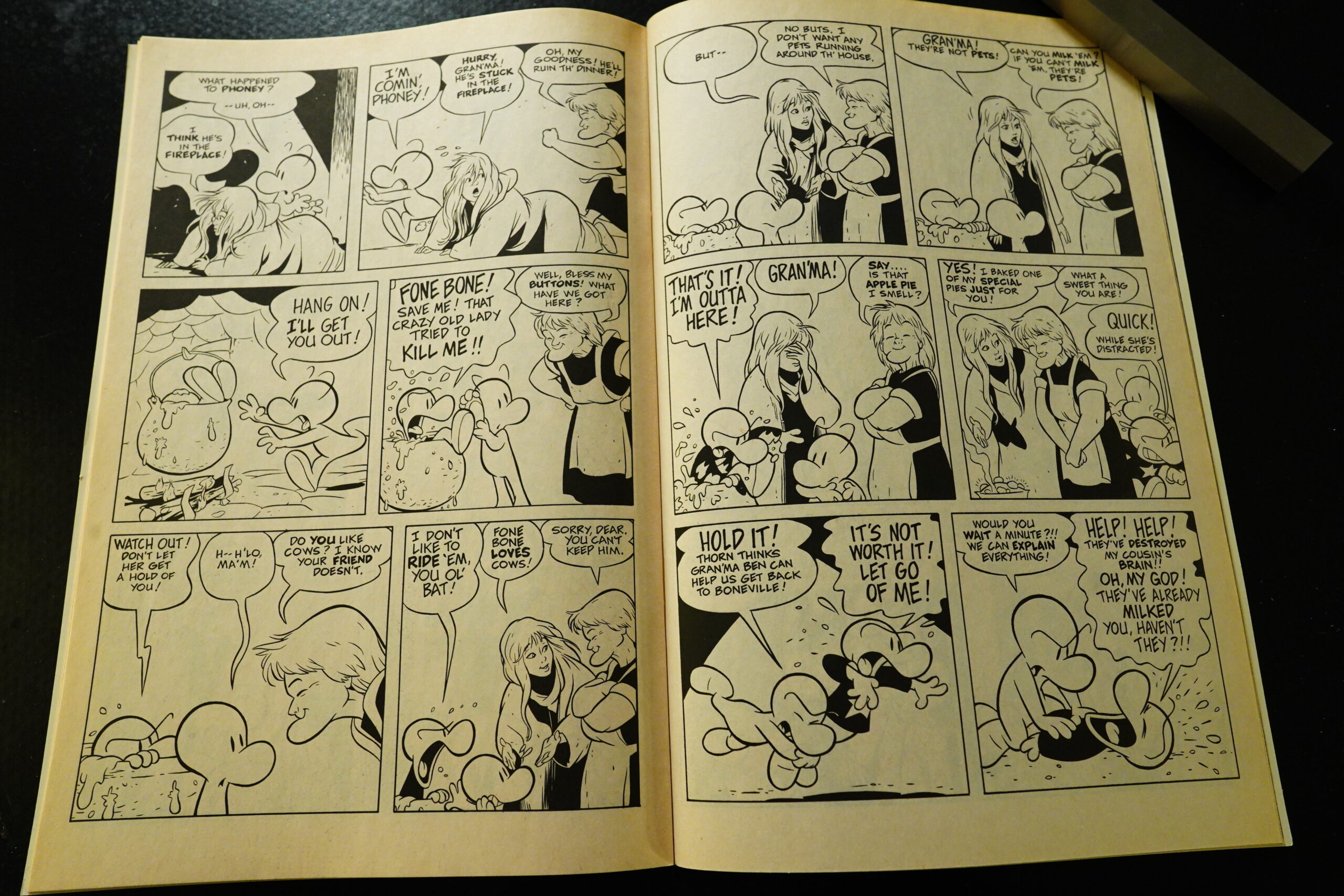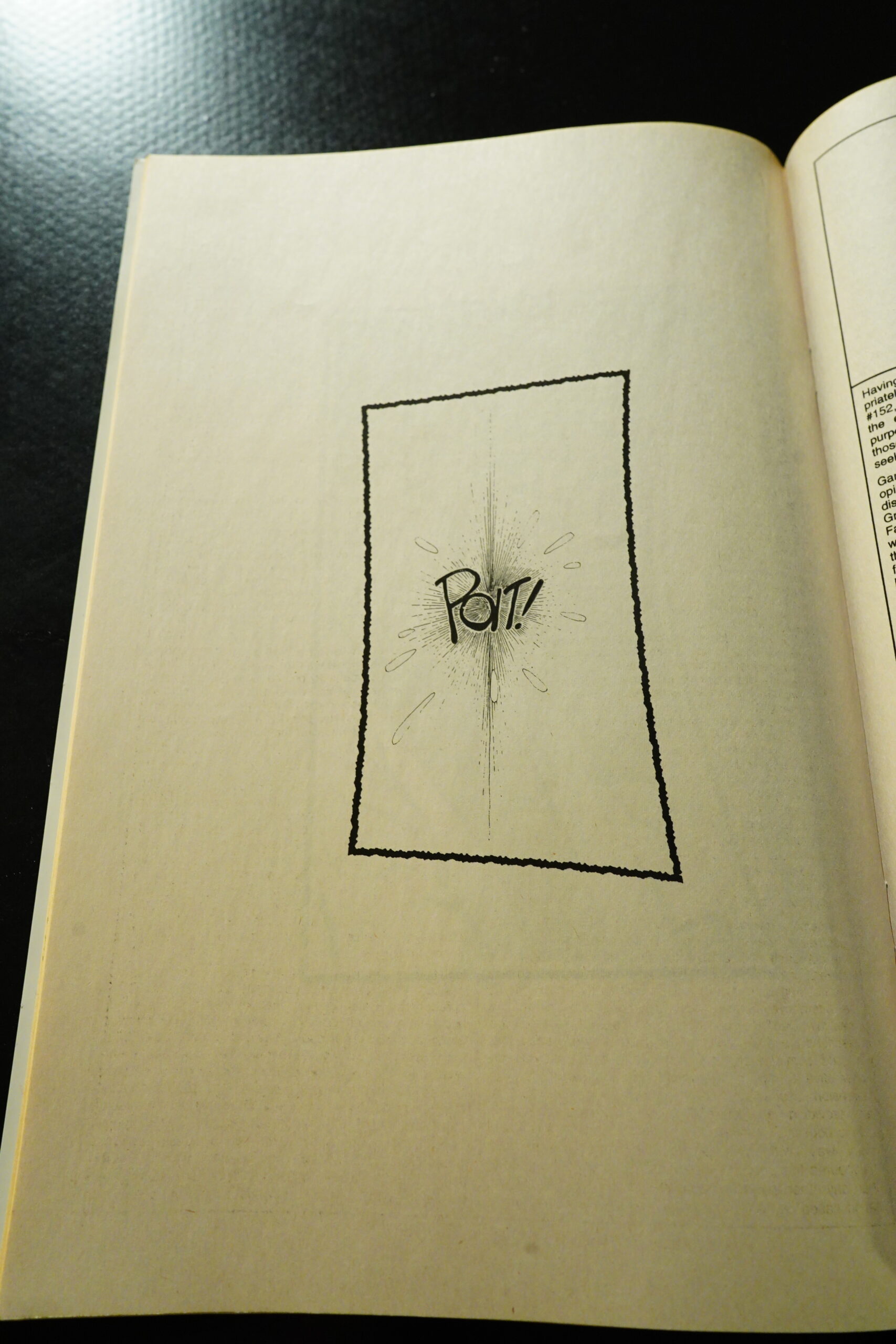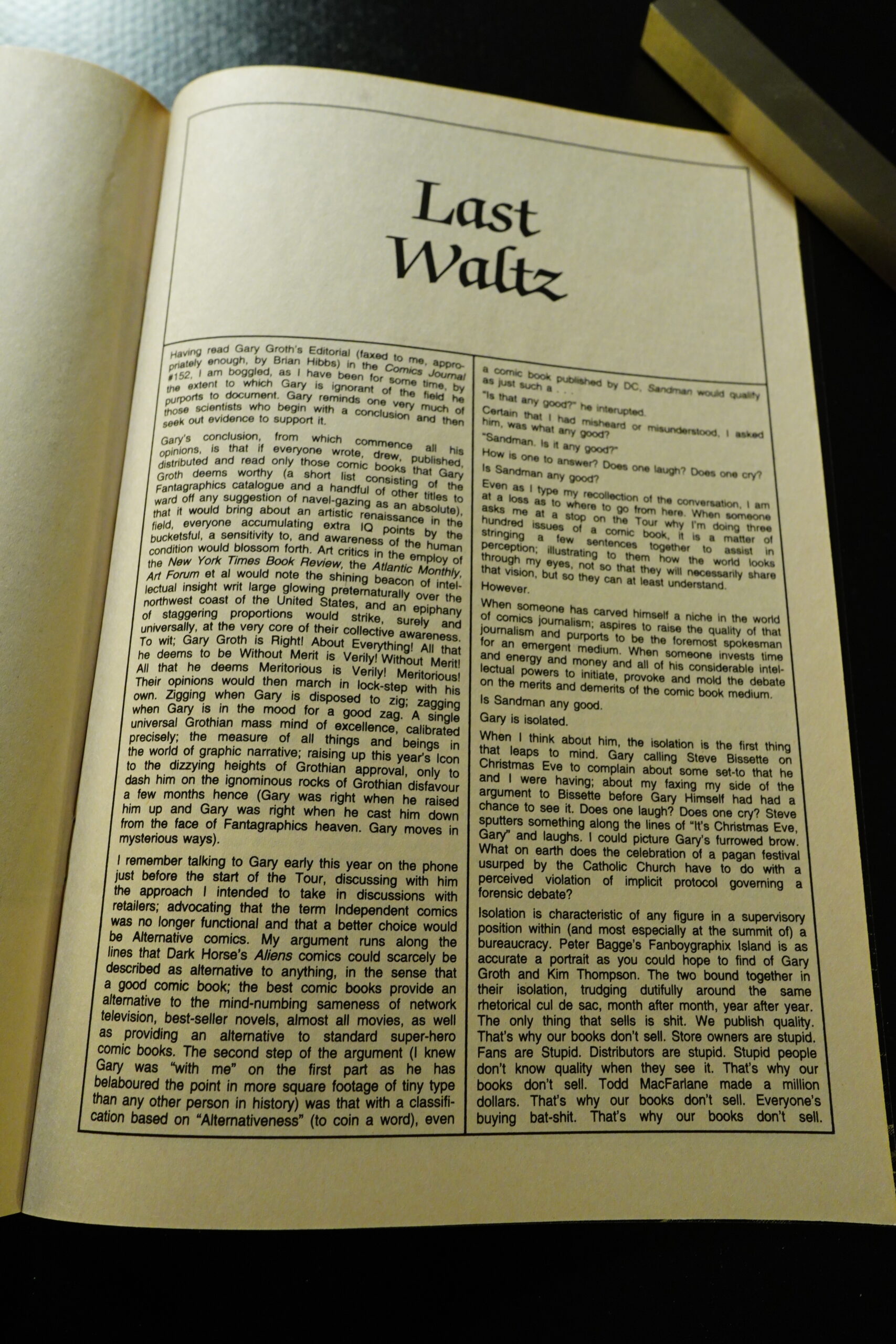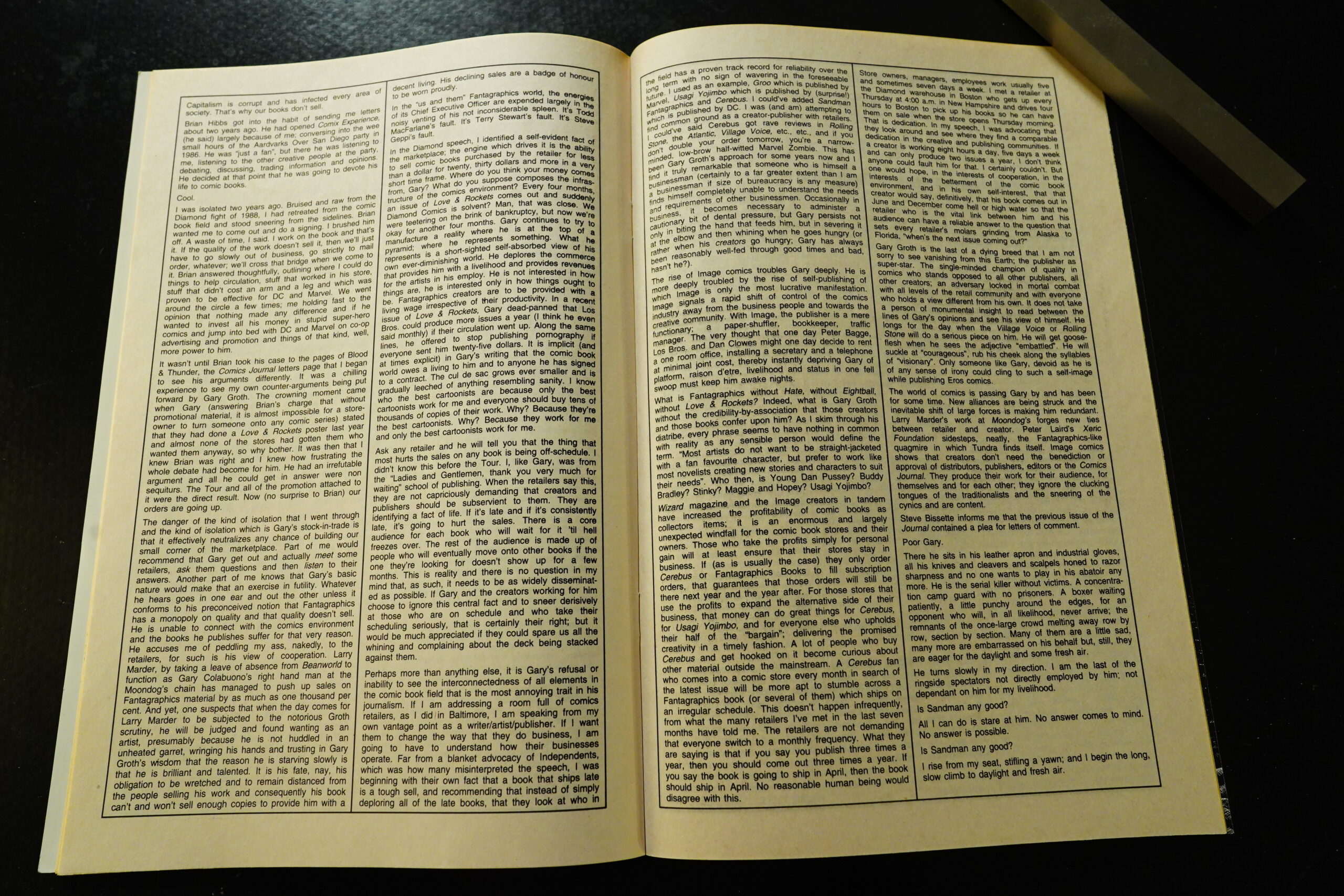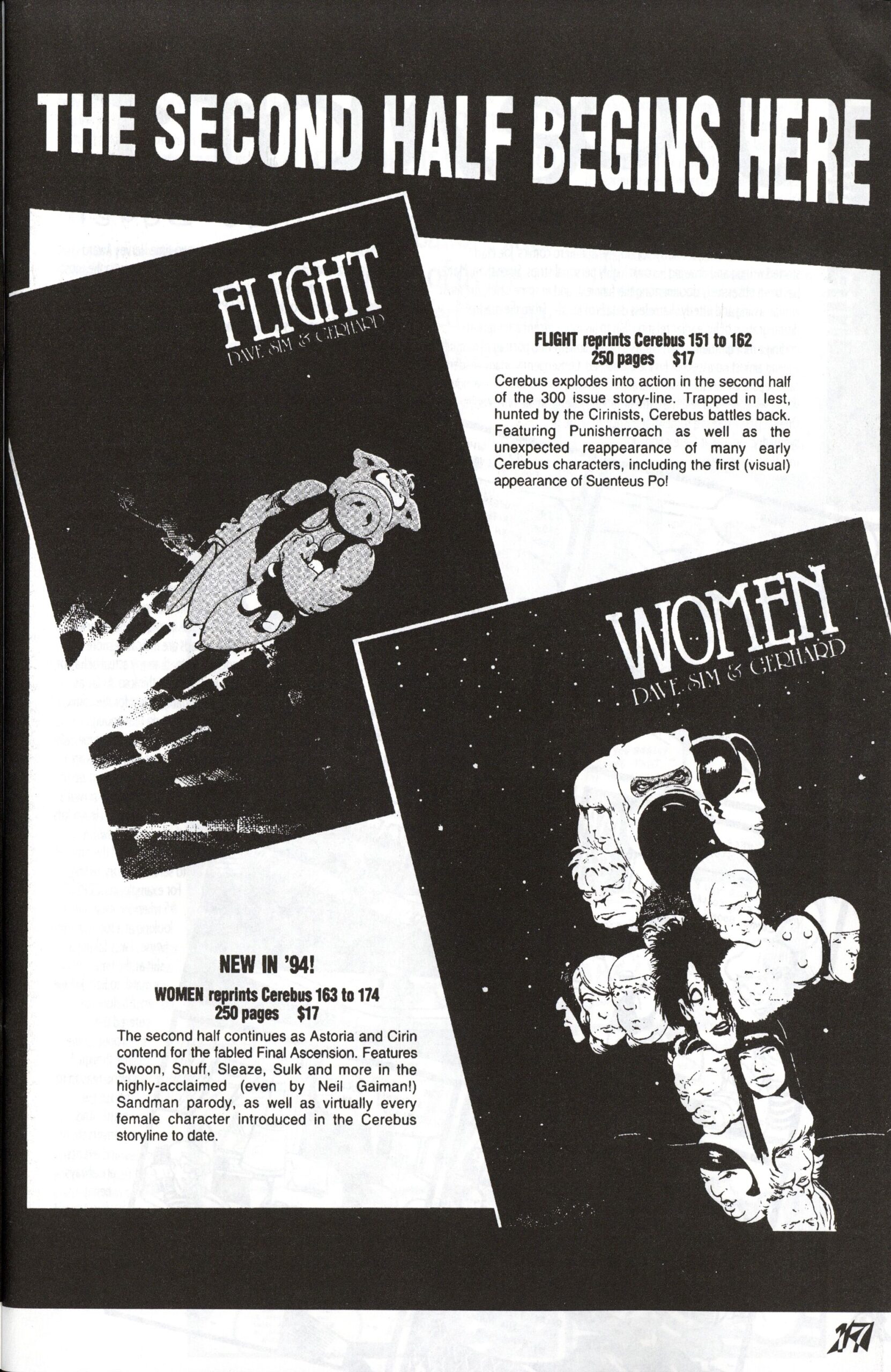Cerebus (1991) #151-162 by Dave Sim and Gerhard
What? Another blog post in the Renegades and Aardvarks series? But that one ended two years ago? Yes, indeed.
I stopped that series after the Renegade portion was complete, because after that I only had Cerebus to write about, and I didn’t feel I had more to say (there were, after all, six Cerebus posts already). But more importantly, I had grown pretty disenchanted by Sim’s stories: When I read Cerebus as a teenager, I thought that all the mysterious, inexplicable stuff was really cool and pointed towards all kinds of interesting things… but when reading Cerebus now, I found that those things were mysterious and inexplicable because those things were really, really stupid.
And badly plotted.
I was getting pretty grouchy in my Cerebus writing, which isn’t fun for me, and is probably even less fun to read.
So why restart the series? It’s just… it felt so… unsatisfying… to not complete this blog project. I mean, it’s just 150 issues of Cerebus? Surely I can gird myself to get that done?
We’ll find out, won’t we?
OK, let’s get started… Er… do I even remember how to do this? Where’s my camera… and I need lighting…
I read Cerebus as it was published — except for a couple of years around this time. Not because I no longer liked Cerebus, but because I was a poor(ish) student, and I just couldn’t afford both buying comics and going to the Cinematheque, so I ditched American comics, for the most part. But I picked up all the missing issues a few years later, but somehow, I never bought #151 and #153, so I’m reading them now for the first time. And I seem to have gotten a second printing of this, which I take to mean that shops had cut their orders on Cerebus during the Melmoth run, but that demand picked up again.
Well, that doesn’t sound promising…
OK, my lighting rig here isn’t optimal — too uneven light. Perhaps if I push the lamp further away?
This is what my super-professional blogging rig looks like, by the way. Gotta have light if you wanna take legible snaps…
OK, that’s better. Is the white balance OK? The white balance cards say “yes”.
ANYWAY! Melmoth ended with Cerebus going into a killing frenzy to get to Cirin to kill her or something, but it feels very much like Church & State Volume 3 from the get-go: We get a lot of portentous stuff happening while Cerebus is trying to do his thing.
In a way, it feels like Sim is mopping up all the supernatural characters he had in the first dozen issues — mostly making short shrift of them. Like — he kills off the Death character over four pages, and some of the other ones don’t even get that.
There’s 20 story pages in each issue, but they’re upwards of 40 pages long. So what we get are pages and pages of letters. Without Sim answering them. They’re mostly about rape and sex and stuff. With some jokes.
I’m guessing Sim snickered while writing “Melmoth: A Short Story. 250 pages.” Because back in those days, “graphic novels” were often 44 pages long, so calling a 250 page book a “short story” sounds like one of his gags. (Of course, these days comic book creators plop out 700 page books at the drop of a hat, seemingly.)
And… Sim more than makes of for the stasis of Melmoth in the first few issues here. (Oh, this blog post is about the first “book” of Mothers & Daughters — Sim stopped collecting Cerebus in vaguely 25-issue chunks, like he’d done until Jaka’s Story — presumably because it didn’t make much economical sense to do so. This blog post is about the issues that went into the “Flight” volume.) And it’s fun! We’ve got action, intrigue, humour… “This’ll learn ’em”, he might have ungrammatically thought of the reaction.
Hey, a letter from Ng Suat Tong…
The first couple issues here feature The Single Page entries from various people, but they stop. They aren’t very distinguished comics, so perhaps Sim thought they’d run their course.
These issues have a satisfying propulsion about them… and then you get those wibbly wobbly bits with supernatural gold coins and stuff, and it’s a lot of fun. The fly in the ointment is, though, that Cerebus (the comic) has been through similar stretches before, and nothing ever comics of nothing, so at this point, it’s hard to get too invested?
So the menfolk attack the Cirinists, and we get a very nice page of sound effects, and with the surprise reveal (as to who’s getting hacked up) on the next page. Although I don’t think anybody would actually be surprised, so it doesn’t quite work…
Instead of The Single Page we instead get more previews and stuff.
I had almost forgotten that Colleen Doran was self publishing A Distant Soil — it’s been such a long and strange publishing saga. I don’t think it’s been finished, even after all these years?
Sim used to write lengthy Notes From The President, but it’s mostly just, er, notes in these issues…
You gotta love these sequences… and whenever the Roach rears his stupid head, you know something “ha ha” is gonna happen.
Another thing that shows up regularly in these issues — Sim showing and/or selling off artwork (where the profits go to the Comic Book Legal Defence Fund).
Sim goes for a really heightened sense of tragedy. The city has been occupied by the Cirinist forces, and they rule with an iron fist, and execute anybody that’s even seen things that may challenge their church. And sequences like this are effective — until you stop to consider that these people suddenly shift from being hysterical masses to facing execution like they’re Marie Antoinette. It doesn’t ring true.
Conversations like the above do, though. That is, it’s the sort of story anybody working in a specialised field tell each other. If I’d had a cent for every time some sysadmin has told me about what kind of moronic thing a lowly user has dared ask for — “and then she wanted the printer to work! the printer!” — I’d probably have a couple of bucks.
Oh yeah, Sim and Gerhard are out on a tour, and here’s some random memorabilia.
We get two issues marked as “Mind Games”, but unlike most previous ones, there’s nothing particularly interesting about them structure wise: We get some chatting with Suentus Po (as usual), and we also follow the other storylines (which didn’t used to happen).
Sim decides to start answering letters again, and that shifts the tone of the letters pages considerably: Less guys talking to each other about sex, and more jokes.
Sim got this strip by Jeff Gillette in the mail, and he was so impressed that he printed the entire thing in one issue. As he well should, because it’s really good. It’s a philosophical ditty that also deals with creating comics, so it’s quite apposite for Cerebus.
Oh yeah, I didn’t mention that the action mostly stopped after a couple of issues, and Cerebus was (as always) distracted. Here Cerebus himself acknowledges that that’s how it always goes. I guess it’s nice that Sim realises that he’s repeating himself.
Trina Robbins does a jam.
The Roach is now Punisheroach, and he’s even more insane than usual. But then again, The Punisher is more of a psycho than Moon Knight, so it all very logical.
Also: Nice sound effect.
Finally! All the secrets! Suentus Po speaketh!
Sim gets a negative review of Melmoth, and notes that he felt he had to have it there — jumping straight from Jaka’s Story to Flight would be too pat. The reader speculates whether Sim just wanted to start the story on #151, and I think… perhaps? Sim is very much into numerical magicks.
Once the tour takes off, Sim starts writing more substantial Notes again, which is nice.
Suentus Po infodumps on Cerebus for most of these issues. And it’s not as fun reading as it could have been, because Po speaks in Sim’s exact own voice: So we’re been lectured by somebody that just makes one claim after another, without any room for discussion. But on the other hand, we’re learning things we’re been wondering about since 1977, so…
“when she was thirteen”!? Was Connie Lingus the woman Sim was accused of grooming a few years back (when Sim was trying to get involved with the Gamegate people)? If so, I missed it…
Oh no! Not Elrod! Poor Roach.
Oh wow, I had forgotten that Bone had started around this time. Sim reprints 20 pages of Bone in one issue, and it’s a lot of fun. I had also forgotten that Bone was this spicy — I read it as it was published (more or less — I missed the first year, but then went back and got it), but I’ve never re-read it. I should do that…
And so ends the first Mothers & Daughters volume.
I have to say… it was more fun to read than I had expected. But there’s definitely sluggish bits — while Sim has excellent instincts when it comes to doing comics, Sim just isn’t a very good prose writer, and there’s a lot of deathly prose in this one. If I remember correctly, it’s going to get a lot worse in subsequent volumes.
But wait! Before we go, we have this rant from Sim directed at something Gary Groth wrote in Comics Journal #152. And in addition, Groth apparently asked him whether Sandman was any good, and this sent Sim over the edge.
“Gary Groth is the last of a dying breed that I am not sorry to see vanishing from this Earth.” And then he ends this monumental hissy fit by intimating how bored he is by the vacuity of such as Gary Groth, who doesn’t even understand the greatness of Sandman. (Meanwhile, of course, Groth is still publishing fantastic comics three decades later, and Sim isn’t.)
But now I wonder what Groth wrote that was so horrifying — it was apparently so emotionally scarring that Sim could even make himself recap it.
Oh, it’s this? Let’s see…
Ah, it’s just about how Image Comics is publishing shitty comics (true) and how Wizard is a harbinger of the death of comics (also true; the speculation Wizard engendered almost broke American comics). That all seems very commonsense, so what’s Sim so angry about? Ah, here we go:
If you think that a comics culture that ac-
tively discourages reading is too obviously loath-
Some to waste one’s time inveighing against,
meet Dave Sim, who thinks it’s just swell.
Sim is the author Of Cerebus rhe Aardvark,
and a talented creator who has, especially in the
last few years, taken on the role Of activist artist/
businessman. Unfortunately, his rhetorical ex-
cesses combine the worst traits of both: the
transparent money-grubbing of the businessman
with the innate moral superiority and arrogance
bestowed exclusively upon the creative soul,
managing the difficult task of making two dia-
metrically oposite positions equally repugnant.
According to a speech Sim delivered to sev-
eral hundred retailers at Diamond’s Baltimore
seminar, the biggest obstacle to fulfilling the
artistic potential of comics is not the recent
backlash against actually reading comics, which
he finds admirable; nor is it the retailer, the dis-
tributor, or even the consumer. It’s the cartoon-
ists themselves. And it’s not the artists and
writers who crank out drek-to-order on an as-
sembly-line basis in a work-for-hire capacity for
Marvel, DC, et al., but the calloonists who have
received the most critical acclaim inside and
outside the comics profession, those most re-
spected by their peers, and who are generally
acknowledged throughout the world as the best
cartoonists in America. The cartoonists who are
“the single largest anchor that is holding the
direct market from fulfilling its nearly limitless
potential” include Robert Crumb, Jaime and
Gilbert Hernandez, Art Spiegelman, Will Eis-
ner, Kim Deitch, Daniel Clowes, Chester
Brown, Julie Doucet, Rick Geary, Drew Fried-
man, Jack Jackson, Justin Green, Joe Sacco, Jim
Woodring, Charles Burns, Bill Griffith, Michael
Dougan, Harvey Pekar, and Alan Moore, among
others. The reason they are an anchor is because
they do not crank out their work on the same
industrial schedule as the average super-hero
comic. Or, as Sim put it:
There is no question that the single larges’ anchor
that is holding the direct market back from fulfill-
ing its nearly limitless potential is the unreliability
of the creators to produce their work on time and
to meet their commimnenl ‘o a publishing sched-
ule. II is one of the biggest reasons I decided to
do Cerebus in the first place. Every small publisher
I vvorked for spent more time talking aboul
‘hey were going to do than they did doing it. I de-
cided that I would produce Three issues ofa comic
book. I would keep the format the same,
keep the title character the same, I muld keep
the approach the same and would do it as I
thought it should be done. Bul, most importantly,
I going to make Sure it came I said
if nas going to come out.
There is no reason for any comic book to be
off schedule; there are only excuses.
And excuses don ‘1 pay your bills and excuses
don ‘I help us move forward as an environment and
an industry. lime and lime again, I tell creators,
whelher they are self-publishing or being published
by someone else, ‘hat if ‘hey can ‘1 es’ablish a
schedule and stick ‘o i’. they are not longer part
of ‘he problem, they are the problem.
In their defense, I will say. again, that they are
human beings. And I will ask you to picture what
the effecl is on a human being who is idealistic,
u•ho is enthusiastic, “ho is delivering his nork on
lime. and who is pouring his heart, his blood, his
sweat and his many, many tears inro a creative
endeavor, ‘o see orders for his first issue come in
at, say, 5,000 copies. He sees this as a founda-
‘ion upon which he can build a fururefor himself.
for his collaborators, for his spouse and for his
family And orders come in for and
are 3,000 copies. On number three and ‘hey are
800 copies. His spirit is broken and, humiliated,
depressed and embarrassed. he crawls anuy 10
lick his nounds.
People ask me What happened to Big Numbers
number Ihree.
That ‘s “hat happened to Big Numbers number
three.
It is more complicated than that, ofcourse, and
much of i! has ro do with Alan Moore and Bill Sien-
kiewicz as human beings and par’S Of their lives
have no place in a talk Of this kind. But I
can tell that the centrul reason. and the mason
yu were the biggest part of, nus the massi’,e drop
in orders bemeen number one and number two.
h nus viened by those two human beings as a
lore of no confidence in the creators who
had given you Watchmen and Elektra: Assassin
less than a year before.
Closer 10 home for many of you, there’s the
experience of Todd McFarlane on the adjectiveless
Spider-Man. I can only speculate what the orders
were like on his final issue, but it doesn ‘t take a
mathematical whiz 10 figure out that it nus min-
uscule percentage of what the first issue sold.
And it ‘s about to happen again.
I , for one, choose ro believe Todd nhen he says
that he nums ro stick with Spawn, that he would
like someday ro be drawing issue 50, issue 75. He
is young and he’s still learning his craft, but his
firs,’ issue is certainly a good deal more accom-
plished and professional than was the first issue
of Cerebus. Bur if you order Spawn the guy you
ordered the adjectiveless Spider-Man, the odds
are Ihar it nun ‘1 be around at issue 10…
As strange as it may sound. Cerebus is really
all ‘ve got…
You know that “hat yu need is comic books
that ‘II ship on rime, comic books thal have readily
idemifiable characters that are fan favorites; you
need the creator of Those characters producing the
book and ‘ou need them to make a commitment
in the long term.
My commitment to yu is that Cerebus#/ was
sold exclusively in comic book stores and in March
right on schedule, issue ofCerebus will
be available exclusively in comic book stores.
I don’t wunl to turn this inro an ad for
Cerebus…
It is not even that Sim is peddling his ass so
nakedly to retailers, but that he’s doing it by pan-
dering to the provincial prejudices of the most
regressive and benighted comics retailers, and
that he saw fit to throw his fellow creators to
the dogs in order to promote himself. Polem-
ical rhetoric is either defiant or complicit; Sim’s
is clearly the latter. In short, he told the most
unenlightened retailers precisely what they
wanted to hear: that they need not feel obligated
to support work of artistic merit because such
work isn’t produced on the schedule that Mar-
vel’s 12-year-old addict has grown accustomed
to. They need no longer concern themselves, if
they ever did, with carrying books by R. Crumb
or Kim Deitch or Dan Clowes or Art Spiegel-
man or Chester Brown, because these artists are
part of the problem.
Sim’s speech comes at a time when many
retailers have the intelligence and committment
to support precisely those artists Sim has des-
ignated as the problem, with the full under-
standing that thoughtful creative work cannot
necessarily be done watching a time clock. Sim-
ilarly, most artists do not want to be straight-
jacketed with a “fan favorite character,” but
prefer to work like most novelists, creating new
characters and stories to suit their needs. Sim
has bought into the standardized industrial pro-
cess and mass culture requirements that the
mainstream comics industry has fostered for
Over 50 years and against which virtually every
outstanding cartoonist has struggled to liberate
himself.
It’s as ifJohn Updike were to give a speech
to Walden Book buyers telling them that they
need not support literary authors who couldn’t
crank out books on the same schedule as a
Stephen King or a Judith Krantz.
Sim’s compassionate examples of broken and
humiliated spirits are off the mark, too.
In fact, Big Numbers #2 sold quite respec-
tably, its sales having nothing whatsoever to do
with the delay of the third issue.
Trying to make retailers feel guilty for not
supporting Todd McFarlane sufficiently is gro-
tesque enough to scrutinize with care. Let’s look
at Todd McFarlane’s particular circumstances
and the worst-case scenario for Spawn sales, and
find out if it’s likely that Todd’s spirit will be
broken and humiliated.
McFarlane made a minimum of
On his Spider-Man run; and approximately
another on the first issue of Spawn.
That’s in the bank, Or more than
most people earn in a lifetime. If Spawn’s sales
decreased by the same percentages as Sim’s hy-
pothetical example, McFarlane would make
only, say, SIDOOOOO on issues two through five;
at this rate, if sales were to drop every issue,
McFarlane would have to give Spawn up at
around issue 500 — unless he were willing to
dip into the interest on his savings in order to
support himself, which I have every confidence
Todd would do. (Of course, Sim’s idea of humil-
iation may be a bit tonier than mere poverty;
this is a man, after all, who stays at the Savoy
in London and serves his guests Beluga caviar
while making pronouncements on such subjects
as the greed of publishers.)
Why would Sim use one of the wealthiest
and most successful artists in comics as an ex-
ample of potential impending spiritual desola-
tion and humiliation, when, in fact, there are
many fine cartoonists doing good, honorable
work at bare subsistence wages? Once again, the
strategy is one of pandering to retailers’ ignor-
ance: Todd McFarlane is at least a known quan-
tity to even the dimmest retailer, with which the
better to extract empathy. One thing is obvious:
whatever sympathy retailers reserve for Todd
McFarlane will certainly not also be reserved
for the obscure alternative artists they’ve never
heard of who actually need !heir support.
If the inflexible timetable of the industrial
process “is one of the biggest reasons [Siml de-
cided to do Cerebus in the first place,” it should
come as no surprise that Sim sees the current
feeding frenzy of the speculator’s market as the
culmination of the American Dream.
Five momhs ago. at the first stop on the Tour, in
San Francisco, A Ipha Flight #106 had just shipped
and was sold our in virtually every store in the
Area wirhin hours. Ins’ neck, in Minneapolis. at
‘he Great Fnslern Convention. I saw a copy with
a price lag of $30 Many of you will cringe and
groan inp.urdly “hen I say (hat. nere is an em-
barrassmem in the direct marker about the invest-
ment speculation side of our business; a shame
that comes naturally to the liberal minded and the
idealistic; a sense of participating in something
unsavory and greedy I don’t see it that guy. I
never have and I never will. Far from something
Seedy and underhanded, it is something very POWL
erful and of great lulue. I could ask everyone in
‘his room “hat rhey muld, or are selling Alpha
Flight #106for. Sixdollars. $10 $12.50 $15. Three
dollars. Some ofyou would price it according to
its Wizard magazine listing; some according to
Comics Values Monthly, some according ro the
Overstreet Update, some at half “hat the guy donn
rhe srreer is charging. What is extraordinary about
this is the autonomy pu have in choosing your
own price. FICh person “ho owns a store con-
trols reality in Ihar store. hu don ‘1 have to phone
head offce to ask how much ro charge for Alpha
Flight #106, yu don instructions 10 raise
or loner your price fmm some distant authority..
Inrry Marder informs me that there are stores in
Chicago selling Free Cerebus for six dollars. Sup-
ply and demand does not apply in the comic book
marketplace. Supply and desire does. bu gunr
it, it ‘s six bucks. You don ‘t want it, someone else
will give me six bucks. If you can get it for three
bucks don rhe street, get it for three bucks down
lhe street. If are a Cerebus fan/collector/in-
ves,’or and ir is rhe only copy they’ve ewer seen,
the odds are they will pay the six bucks. Desire
0 vercomes reason.
Viewed one guy, rhe way that causes most Of
you to be embarrassed by this by this side of your
business, rhis is grasping, suinish, piggy capital-
ism Viewed another Buy, the my I see it, it repre
sents businessconfidence, optimism in ourfulure.
a tangible manifestation in hard currency ofa be-
lief in ourselves and Bhar “e , comic book creators,
publishers, distributors, nurehouse personnel, re-
tailers, fans, collectors, readers and imestors have
built from nothing into a $IØOOO,OOO a year in-
dustry in less than three decades.
That last sentence must be some sort of master-
piece. I doubt if the combined rhetorical genius
of Ayn Rand, Oliver Stone, and Peggy Noonan
could have whipped together more unctuous
sentiments and patriotic themes in a single line.
Basically, Sim is telling retailers what Ivan Boe-
sky told a campus audience at Berkeley on
September 12, 1985: “Greed is all right. Every-
body should be a little greedy… You shouldn’t
feel guilty.” (It remains unknown whether Boe-
sky felt guilty during his subsequent internment
in a federal prison.) You have to admit, Sim
covered every base: there’s the obligatory wor-
ship of economic growth as an end in itself, the
worship of size, and, my favorite, the mythology
that the entrepreneur is an autonomous agent
in the free market. This last statement deserves
disabusement.
Each store does not in fact “control reality
in that store,” nor do retailers have the least
“autonomy in choosing your own price.” The
prices for commodities are dictated by external
market forces; one’s indifference to these forces
is usually met swiftly with bankruptcy. The rea-
son prices are more or less standardized, both
for collectibles and newly manufactured pro-
ducts, is because of something called macroeco-
nomics, which is to say that we are all roughly
at the mercxy of the same economic reality. If
a retailer wanted to indulge a perverse urge and
price a single comic eccentrically, he could do
so; but he could not engage in this practice wide-
ly without suffering economic reprisal. This is
why Dave Sim couldn’t sell Cerebus at 25 cents
a copy just because he wanted Co, nor could he
charge $10. Cerebus retails for the same price
as every other like comic precisely because he
does not control reality within his business en-
terprise. Stores sell comics for the same price,
given regional quirks, for the very good reason
that they would quickly go out of business if they
chose to sell comics at much less or much more
than their competitors.
Sim’s boosterism for the speculator’s market
sounds like a Republican speech to the Kansas
City Chamber of Commerce, but it’s hard to
believe that even the biggest flag-waving yokel
would be persuaded to take pride in bilking 12
year-olds by selling them useless garbage at ar-
tificially inflated prices. But, perhaps I overes-
timate the intelligence of the American public.
Sim began his speech with an anecdote. He
told Will Eisner how much of an impact Eisner’s
speech to retailers the previous year had on him,
to which Eisner reportedly replied, “Dave, Ire-
tailersl come up and tell you ‘What a great
speech, way to go!,’ but when it comes down
to it they never change a damn thing.” If it’s pos-
Sible to disagree with someone sycophantically,
Sim manages to do it: “It takes a great deal for
me to disagree with Mr. Eisner, so great is the
respect I have for him and his accomplishments
in our field, but disagree with him I did, and
vehemently.” According to Sim and contrary to
Eisner, “There is change going on; fundamen-
tal change, profound change, positive change,
lasting change.”
While I’ll agree that there are changes afoot
and that they may be fundamental, profound,
and lasting, they could only be considered posi-
tive if you harbored a pathological hatred for
literacy and culture. Recent changes, and their
accelerated pace, should be profoundly disturb-
ing to anyone who loves beauty, wit, charm,
honesty, truth, originality, or any other old-fash-
ioned properties once attributed to drawing and
writing, and which are now frowned upon as
impediments to commerce.
Well, I think Groth won that one, don’t you?
Anyway, back to Flight. Were there any reviews or things? Sim is interviewed by Tom Spurgeon in The Comics Journal #192, page 72:
VERY, VERY
SUBTLE BEINGS
SPURGEON: You’ve
written that thefour books
that make up Mothers and
Daughters — Flight,
Women, Reads, and
Minds — were going to
say the same thing in dif-
ferent HOW _you
arrive at that structure?
another
rising action effect very
much along the lines that
I used with Church and
State, because I was do-
ing the mirror image of
that. But I didn’t want to
use the same sort oftech-
niques. I wanted far more
Ofa staccato effect, which
I think I managed to
achieve. The problem is
that a lot ofthe stuff that
I was trying to get across
in Mothers andDaugbters
you really have to sketch
around when you’ re talk-
ing about women. les not
a direct kind of thing.
Theyre very, very subtle
beings, so the episodic
approach [becomes ap-
propriate]: “Here, I’m
going to show it you.
Okay, I just showed it to
you again. I’m going to
show it to you again.
Here’s the same thing
slightly different. Here’s
a different permutation
Of it.” And leaving it up
to the reader to be able to
make the proper assess-
ment of it.
SNRGEON: Was there afor-
mal choice of approach for
each book ?
SIR A number of differ-
ent approaches to each
book. One of them was
that the story ends with
Cerebus and I in conver-
sation, so essenti ally I weas
trying to create a stand-
in for me at the specific
juncture [in Flightjwhere
Cerebus is rising through the seventh sphere and he
just wants to know whaes up there, He wants to know
whads up there and he wants to know who’s up there.
And there’s the obvious structure of the dialogue:
Turn back here. I’m going to distract you, I’m going
to misdirect you, I’m going to do all of these things.”
Nope; none of thaes working until I introduce the sort
Of giant, nebulous form of Suenteus po and the chess
game and that does the trick. But again, only tempo-
rarily, and then he goes, “No. I really want to know. I
want this brought to a head. Brought to conclusion.”
Because in a lot ofways what rm doing is attempting
through the act of creativity to to’ and understand and
try and develop some level ofunderstandi ng ofwhat is
that big thing up there: the cosmic muffin, God, the
Life Force, whatever you want to call it. I spent a
number of years trying to be hot on its trail. I have no
idea ifl’m hot on its trail or ifit’sjust a weird little voice
in my head, Or what it is. But that’s what I was dealing
with in the climax of Church and State and the climax
Of Mothers and Daughters.
Here’s an ad…
AH: The first several issues of ‘Moth-
ers and Daughters” have been the
most surprising things I’ve read or
seen in a long time. ‘ ‘Melmoth” and
‘ ‘Jaka’s Story” are very down-to-
earth, almost peaceful books. Even
the events of the second half of
‘ ‘Jaka ‘s Story ” couldn ‘t prepare me
for issue #150.
SIM: A lot of people forget the fact
that I have been writing this for a long
time. This is unique in any kind of
literary sense, because no one before
has created this sort of work and at
the same time published it. And cer-
tainly not over the course of 26 years.
That’s what makes Cerebus very dif-
ficult to review. There’s no way of
knowing how the story ends, so the
reviewer looks pretty foolish at the
moment the next novel begins.
AH: There was that review in The
Comics Journal about the first halfof
“Jaka ‘s Story,’ ‘ and the roiewer com-
pletely missed it.
SIM: They do tend to leave me alone
after awhile because they do get think-
ing, “I’m tired of looking foolish on
this. I’ll wait until he’s done and then
call it a piece of shit.” I think if the
reviewers don’t take themselves too
seriously, they can have fun with it.
You can help people to get a Reader’s
Digest version of the thing. which I
think is a great deal of the function
of reviewer.
It’s a little bit difficult to do a flat-
out negative review, because most
negative reviews have to be based on
what the thing is. Cerebus has very
little to do with what the reviewers say
about it.
Wizard: Has “Mothers &
Daughters” brought people back
to the fold?
Sim: I think that’s true. I
think it’s also true that there are
people who are just discovering
the book for the first time. I
hadn’t realized that it was no
longer possible to just allow the
you’re a store where you want to
sell out in a week. All of these
things, as we drift towards them,
pull away from what Cerebus is,
because obviously its greatest
strength in the store is if you
have all the reprint volumes and
the current issue.
Wizard: Did people lose
interest in your unique world
view? You went from doing a
Barry Windsor-Smith Conan par-
ody…
Sim: Or rip-off…
OK, I can’t find any contemporaneous reviews, but here’s some from the webs:
It’s no surprise this book caused a shit-storm when it came out, and it would only get worse with later volumes. Many feminists accused Sim of misogyny, and both sides entered into heated and pointless debates. So, if you’re a feminist, you’re really probably not going to enjoy it, and readers who can see past that still have to struggle with a book that explores metaphysical and spiritual matters with a depth that’s unusual for a comic. Too mature for its intended ‘mature’ audience, too esoteric, or just too misogynistic?
The Goodreads rating is surprisingly low (3.7):
this was going well until the central character sort of wandered off into a black screen for too long. i dunno.
And here’s a more recent re-read:
This is the most we’ve ever learned about who Cerebus really is, where he comes from, and what makes him tick. We’re going to get a lot more of that coming up. Secondly, we also learn a lot more about the Cirinists, particularly their telepathic ability.
OK, I think that’s it… onto the next volume, I guess?
This blog post is part of the Renegades and Aardvarks series.
